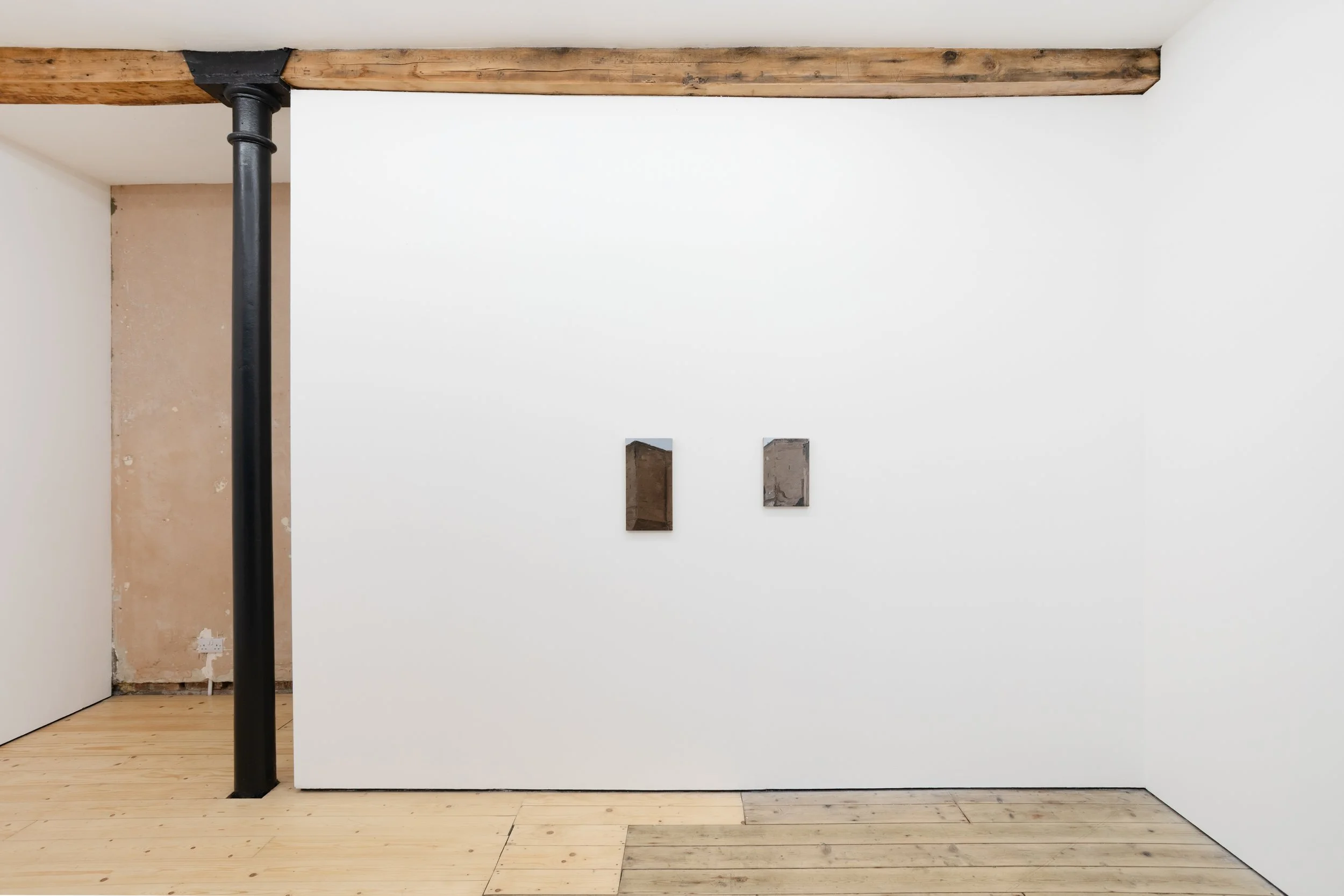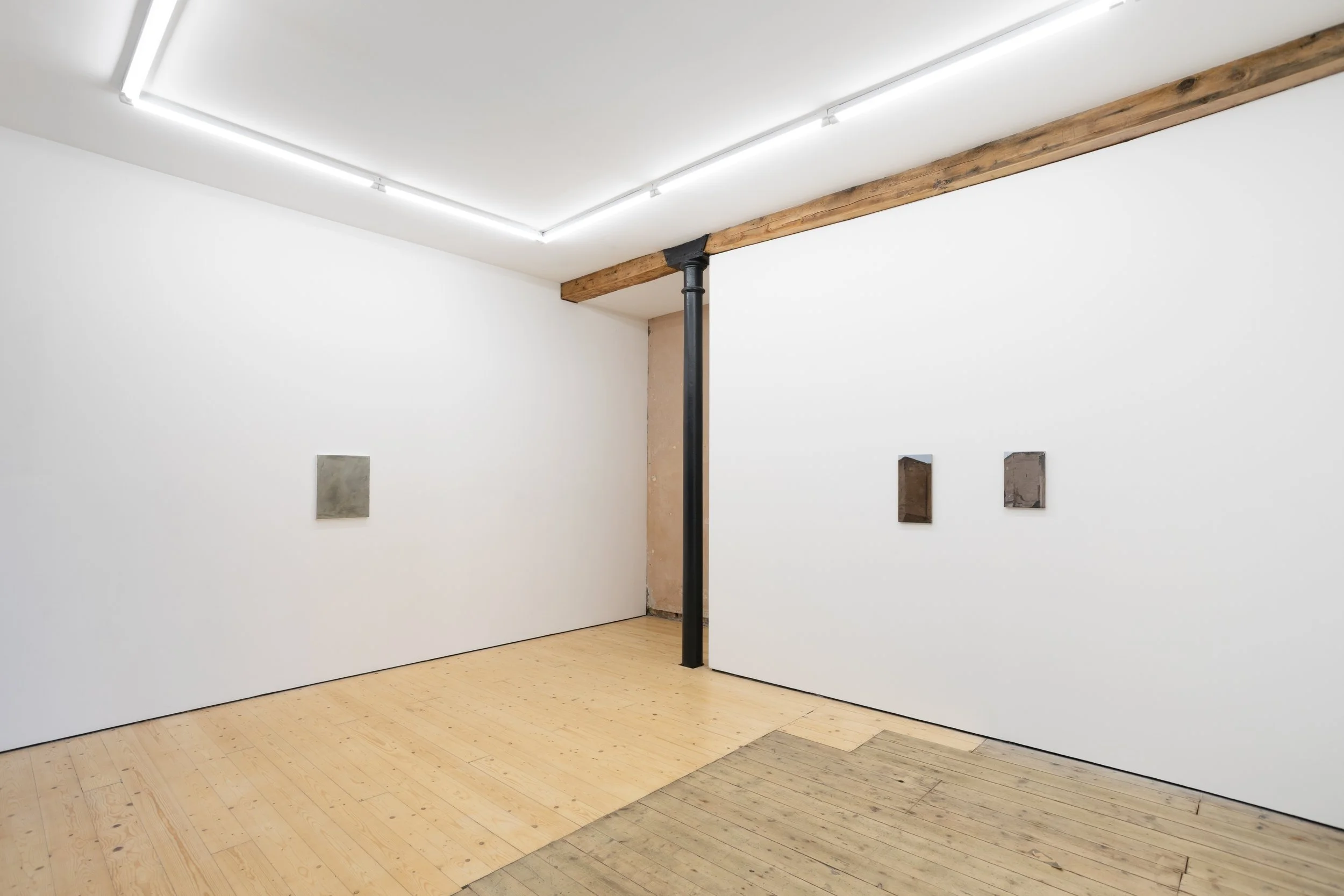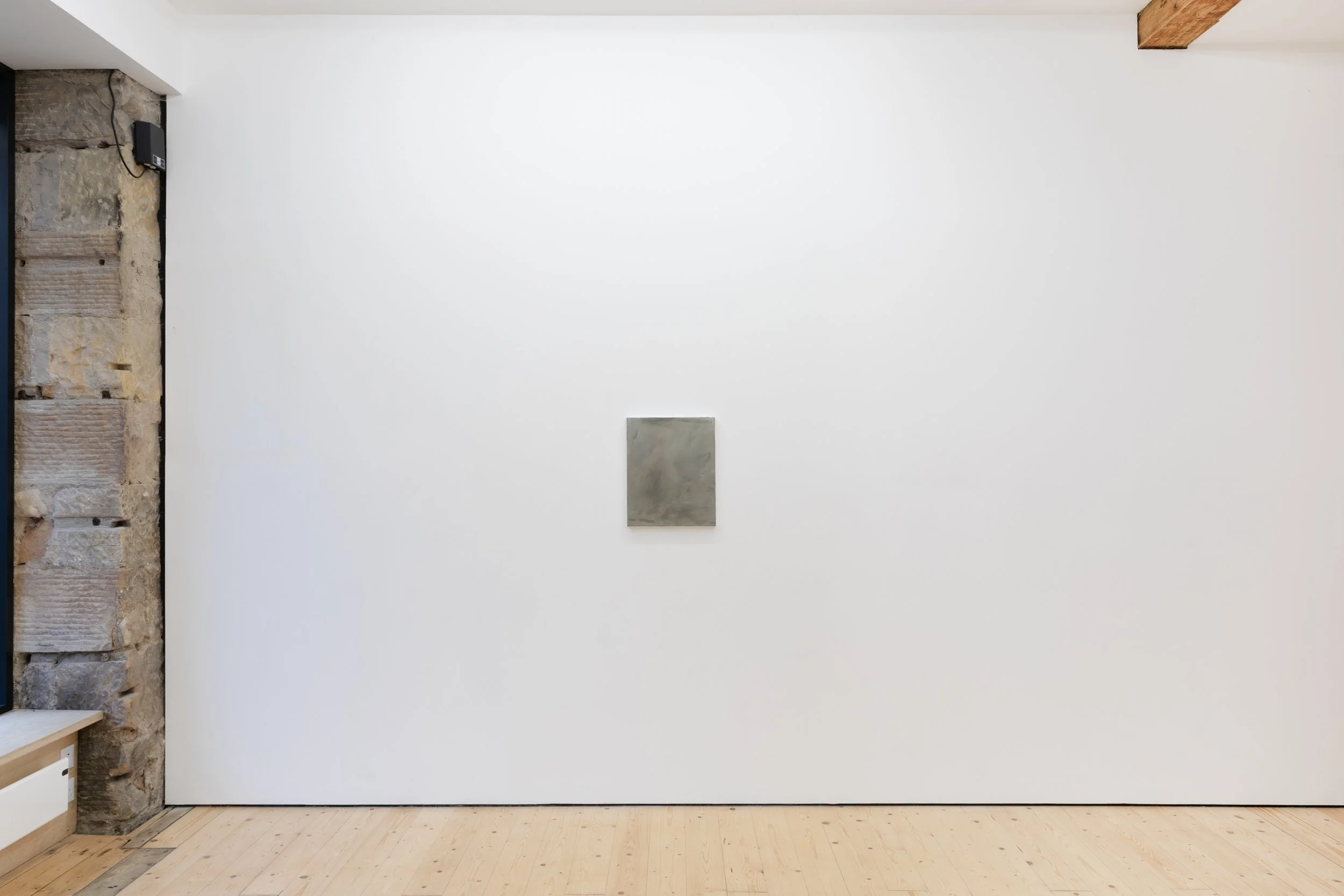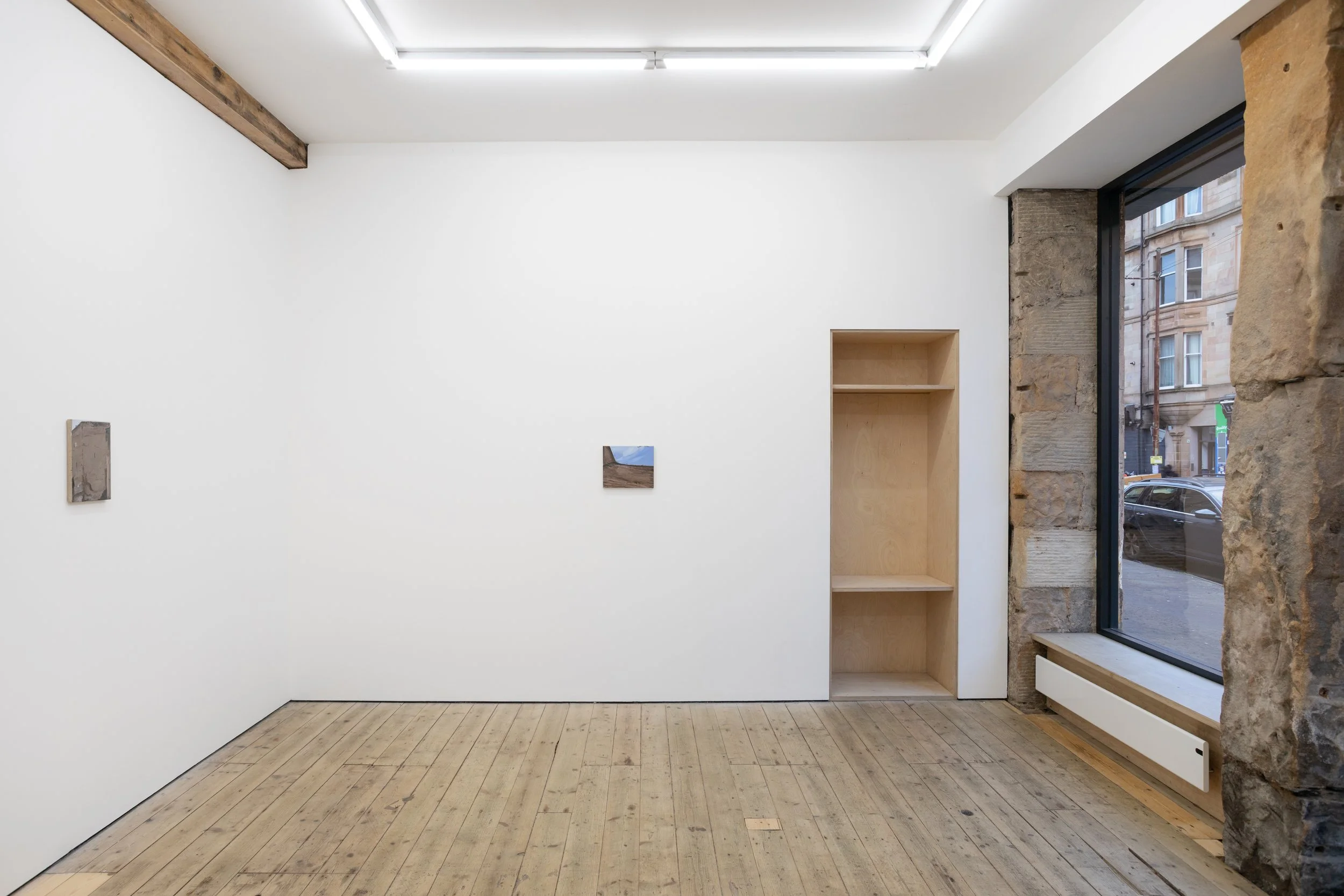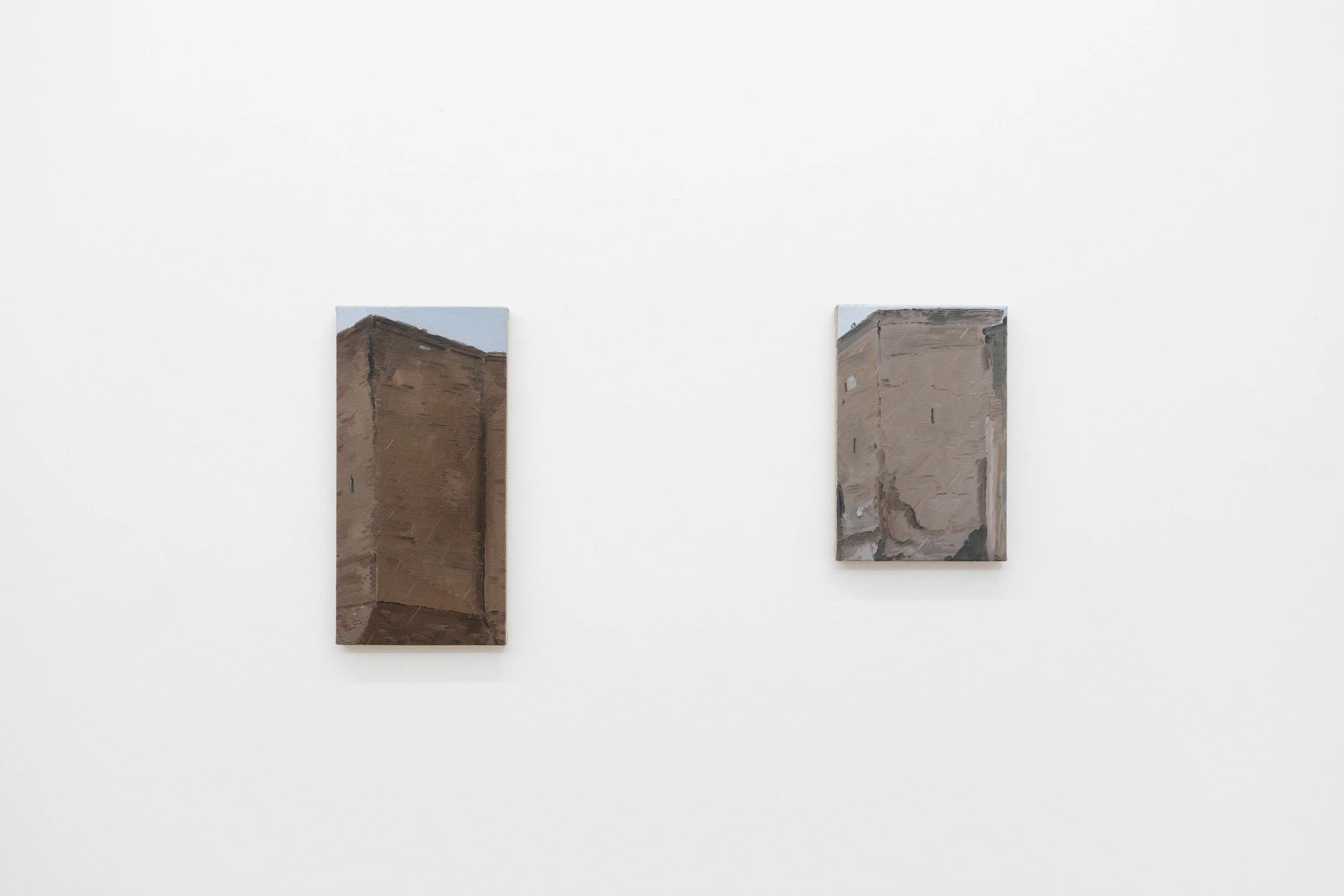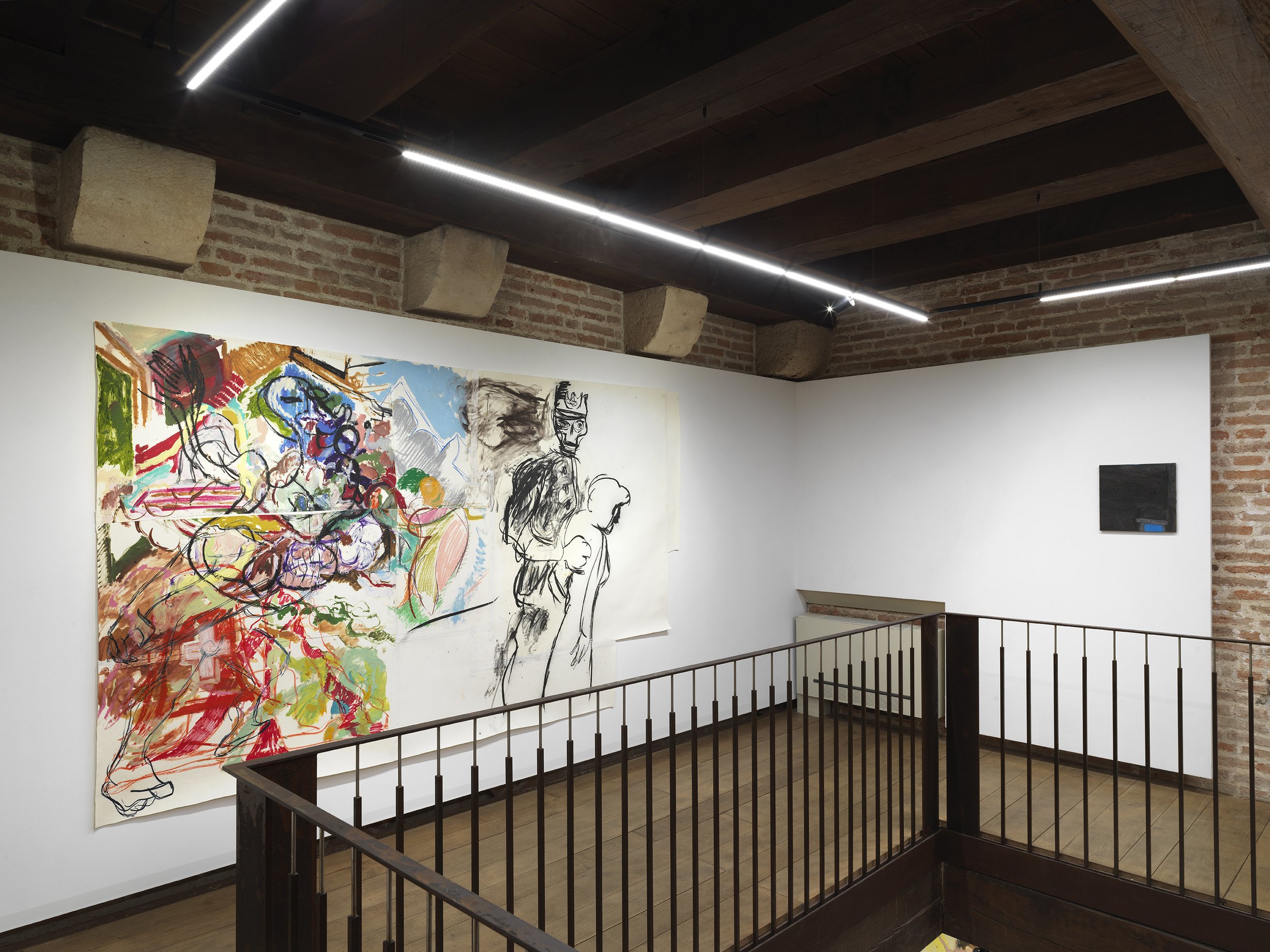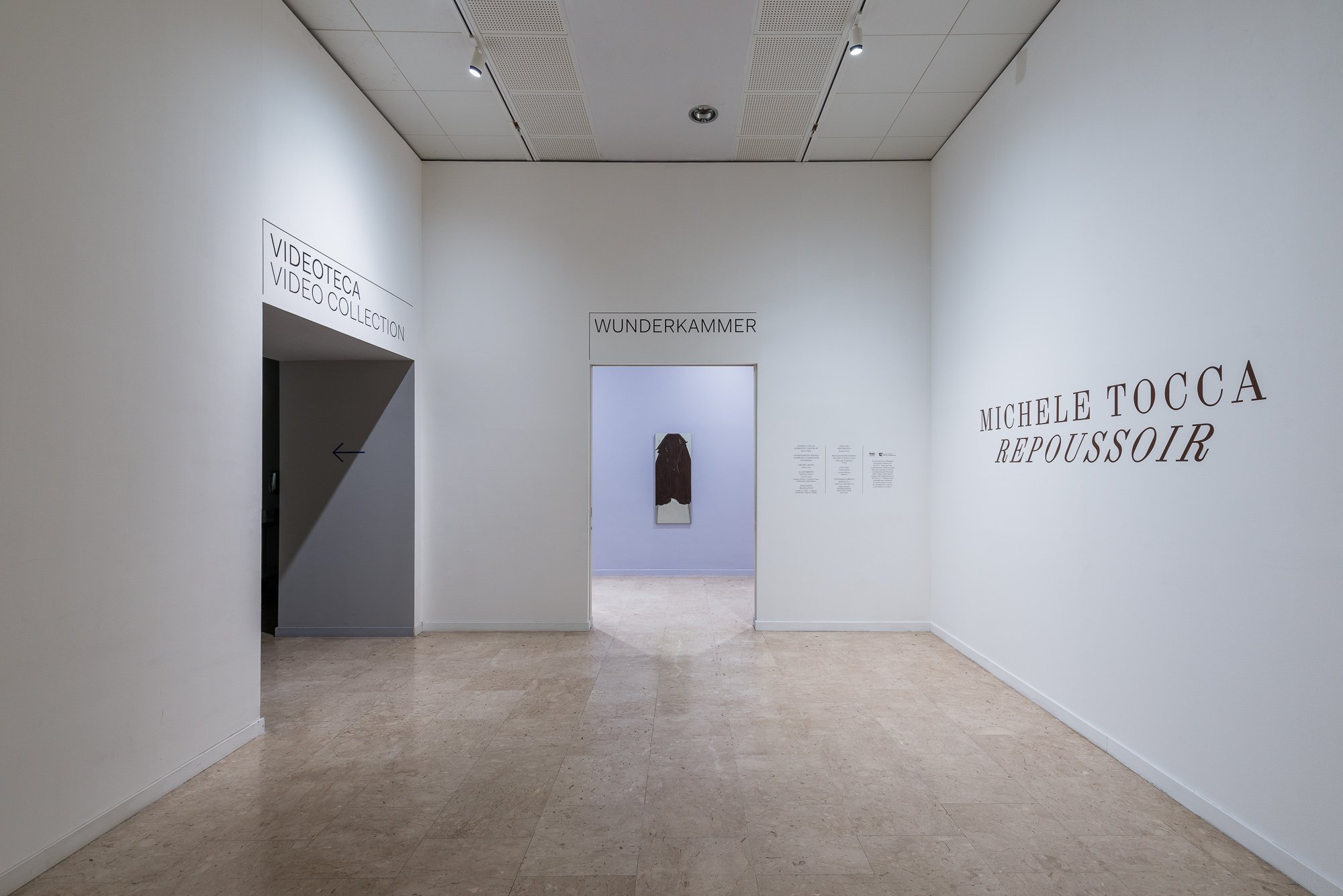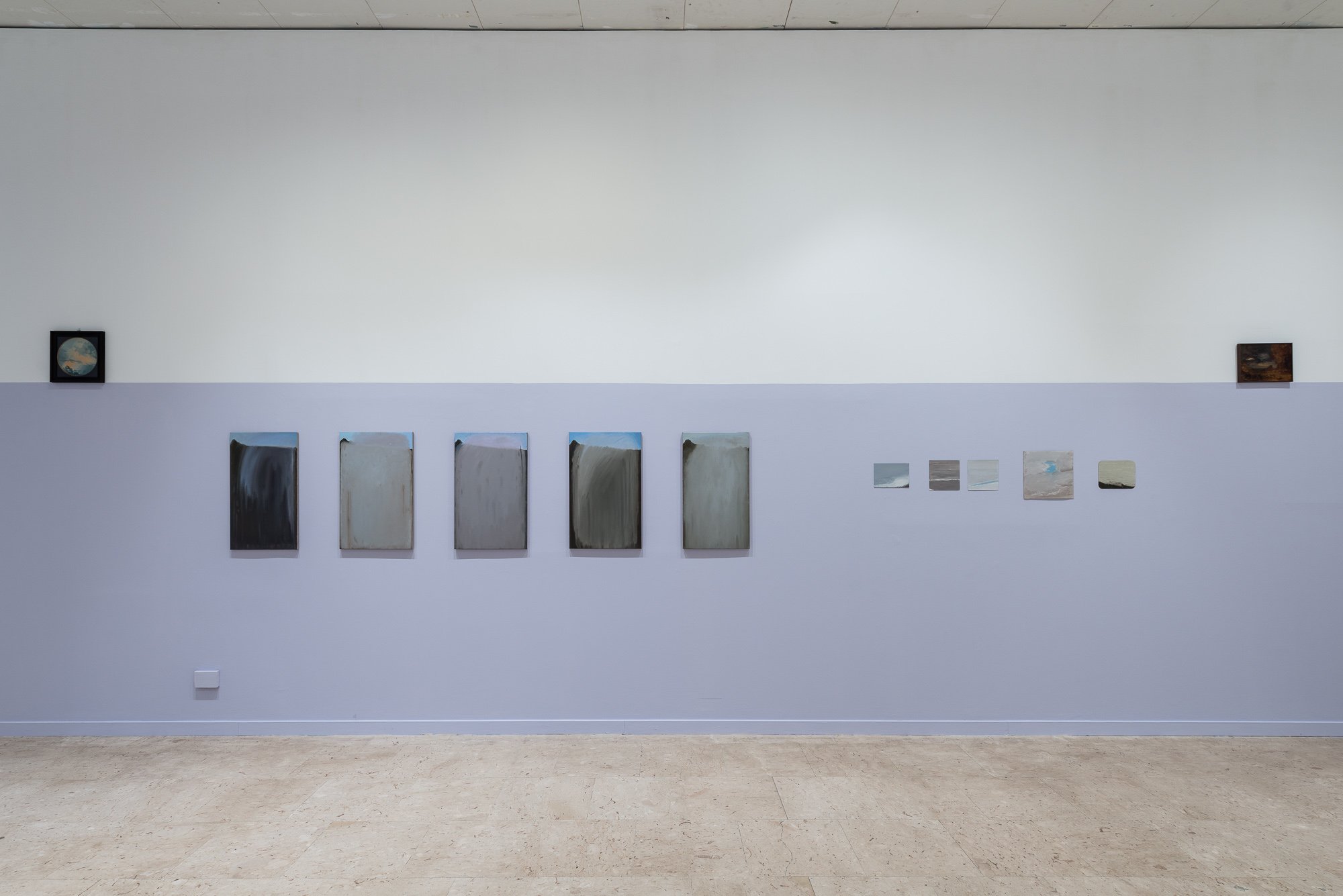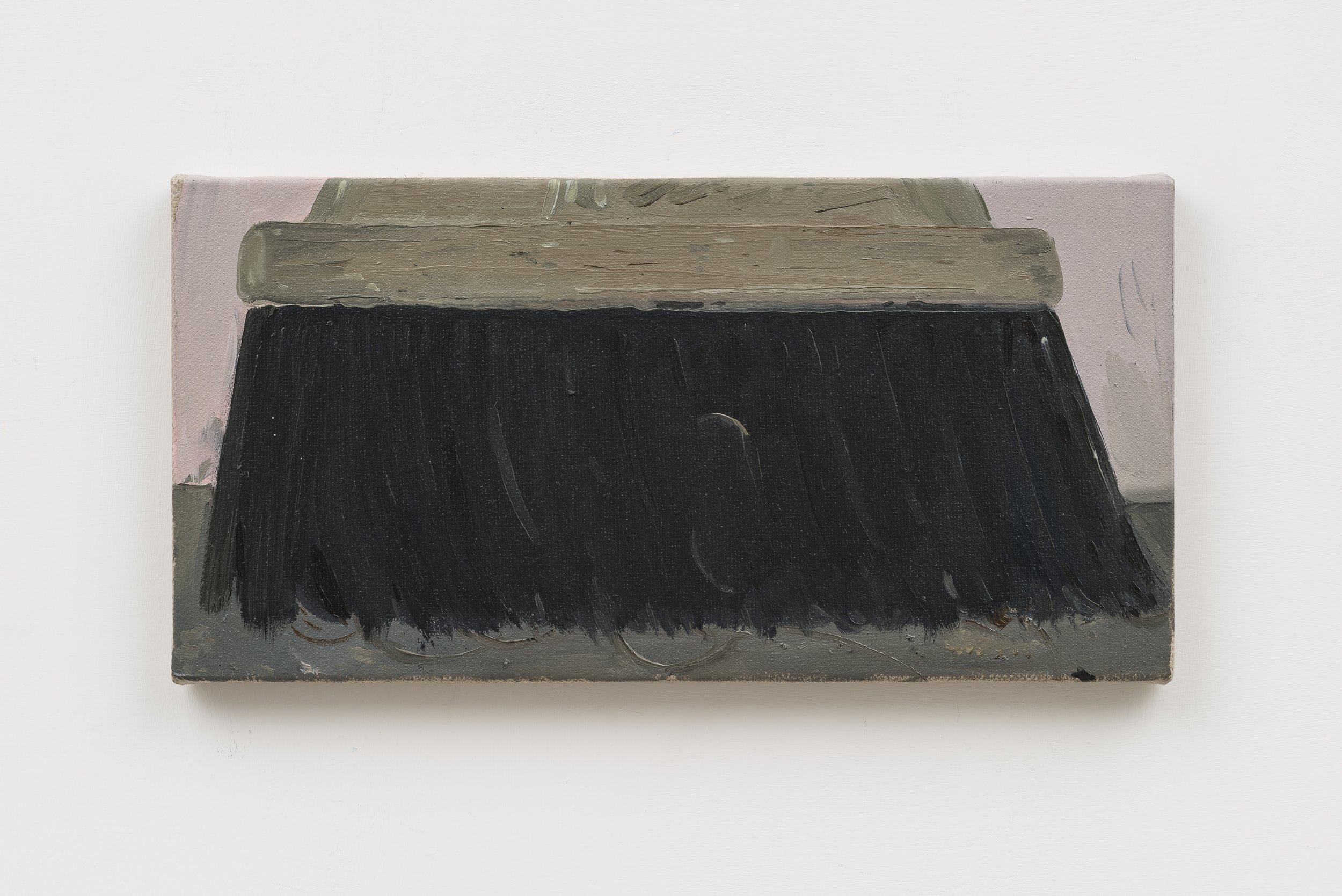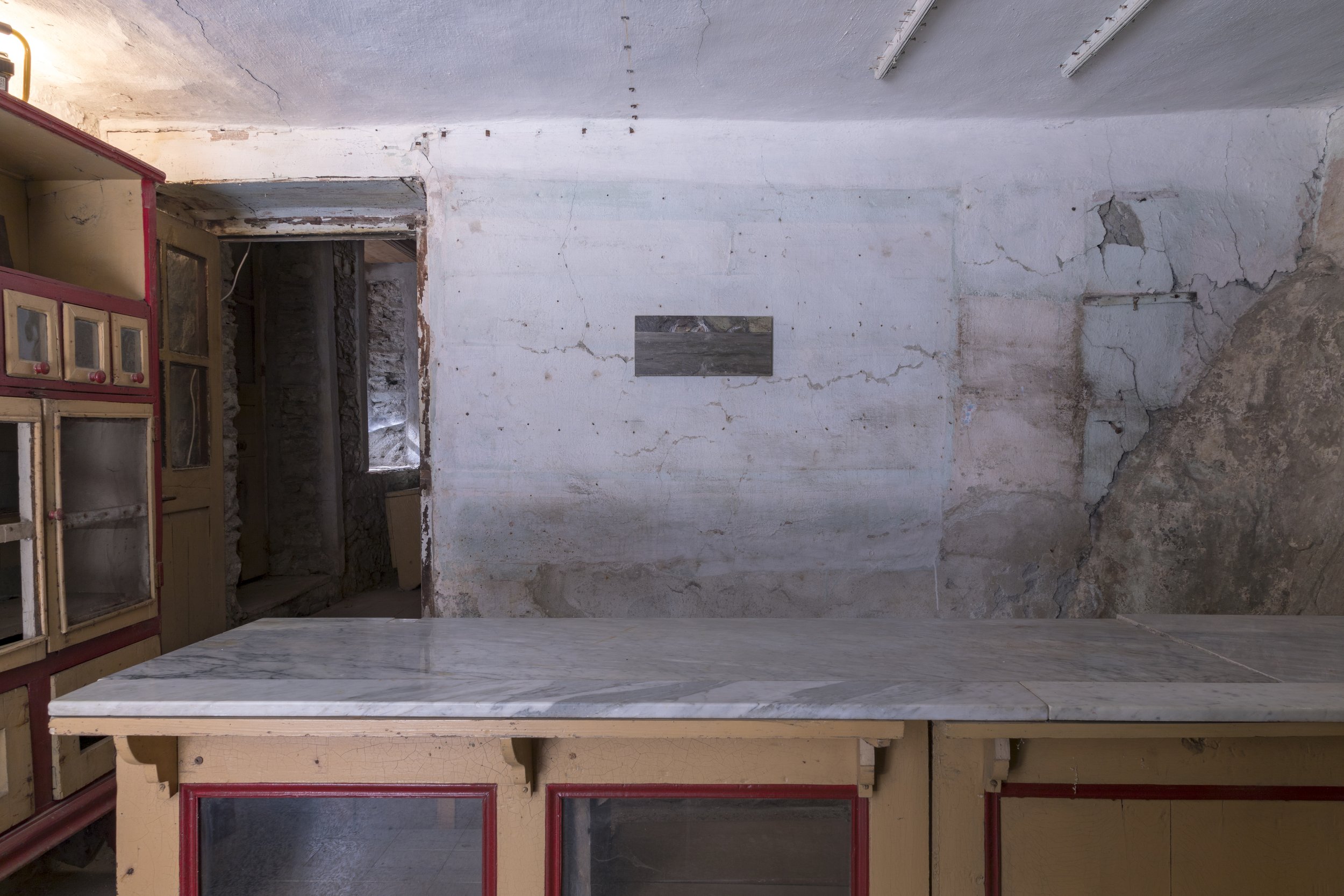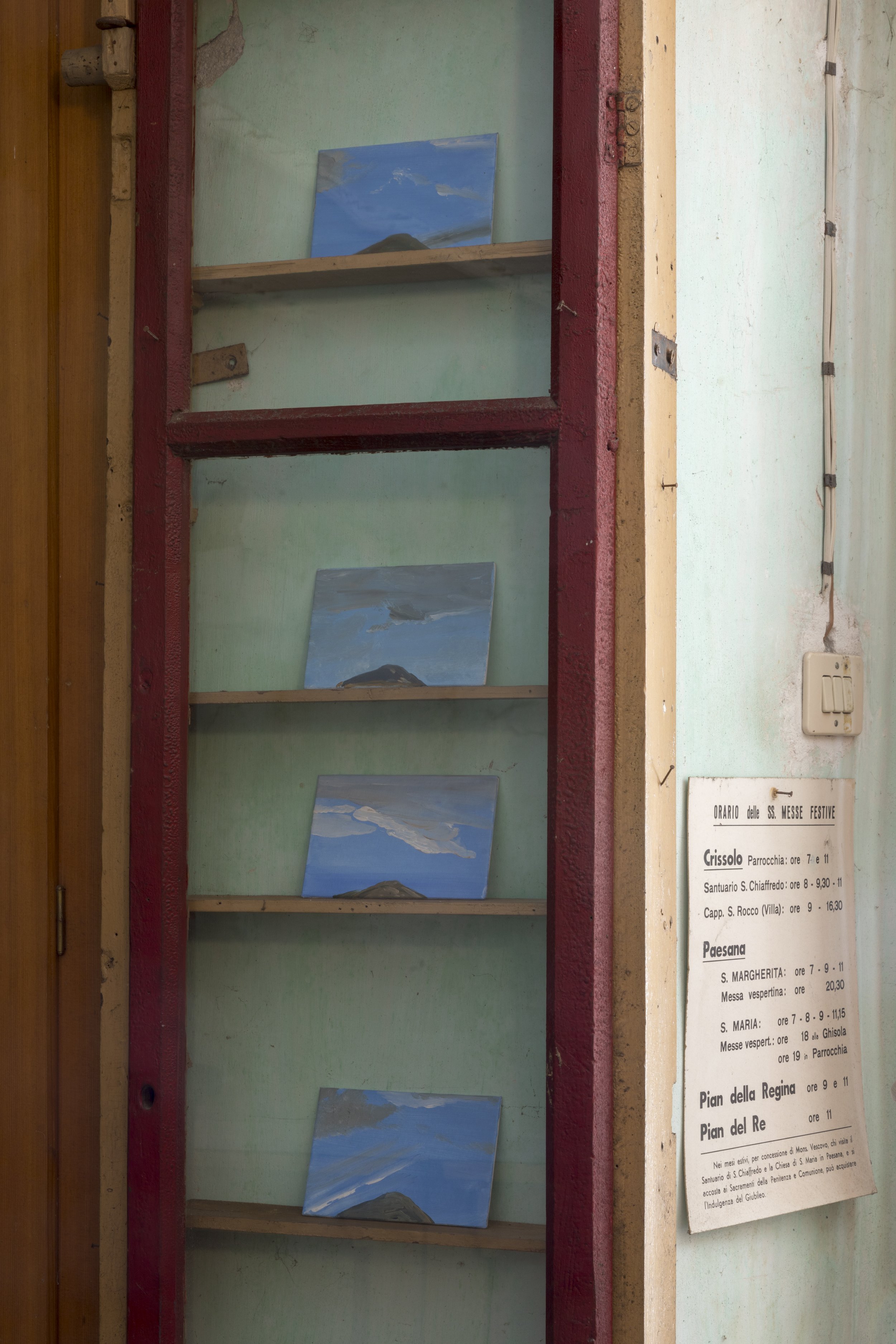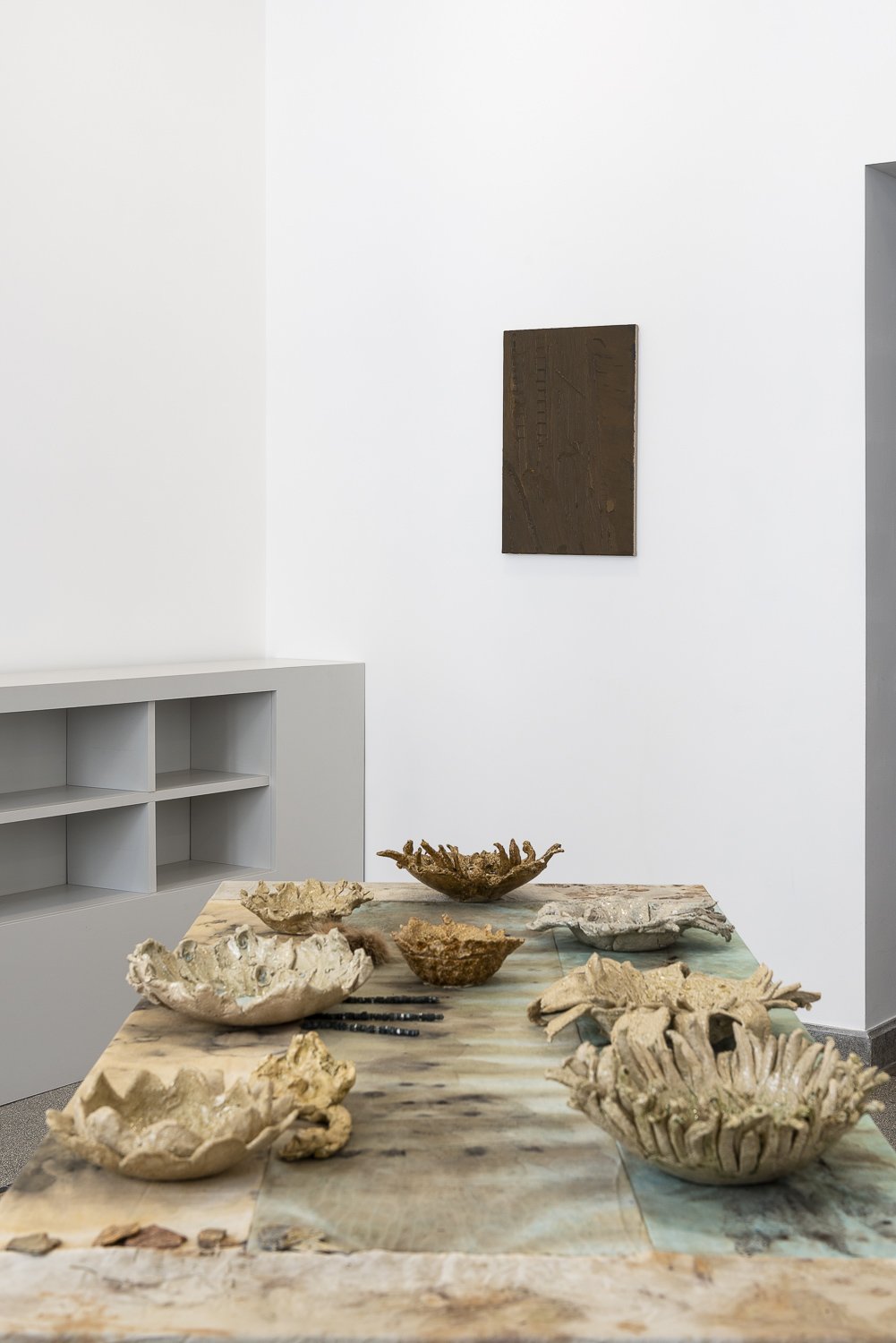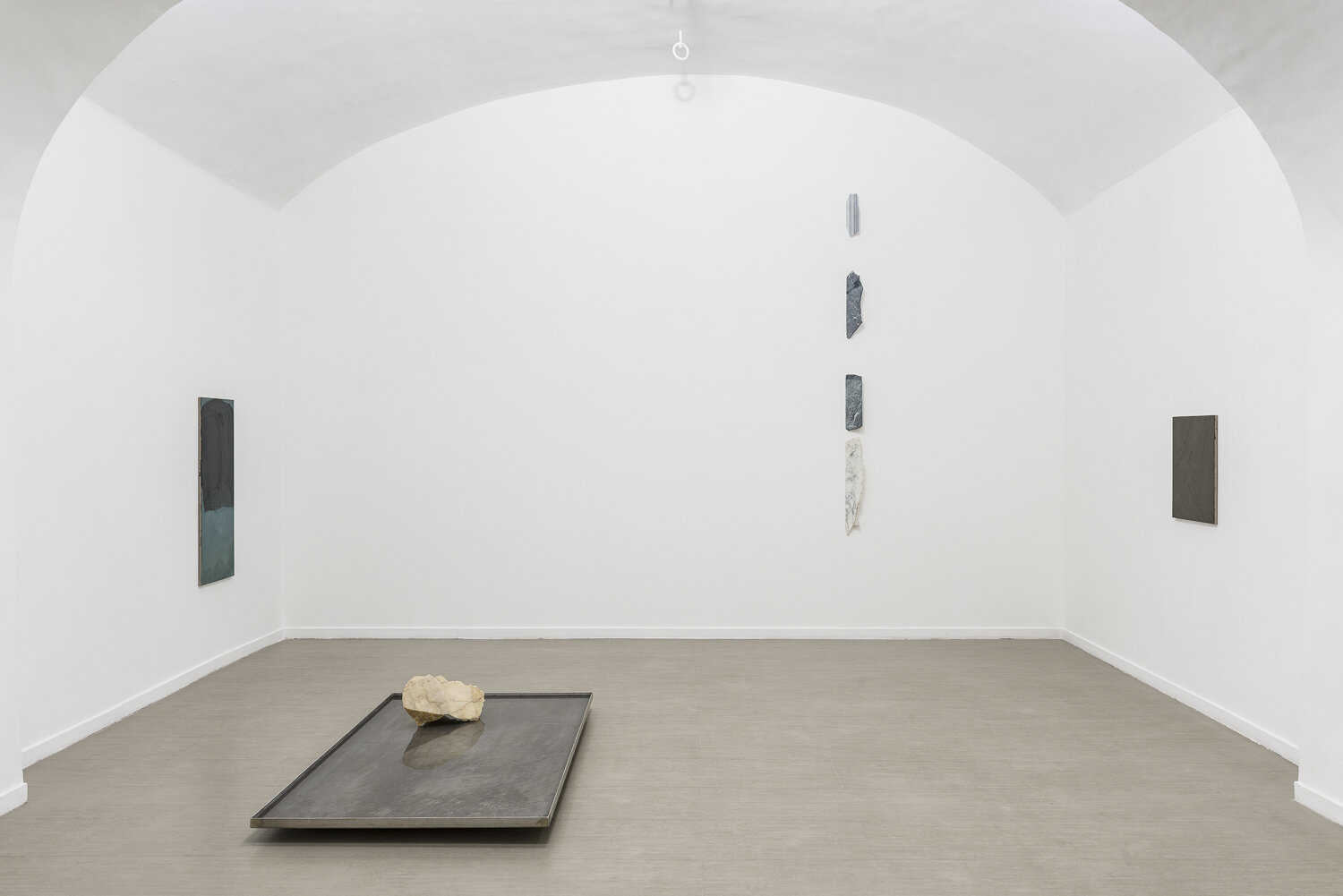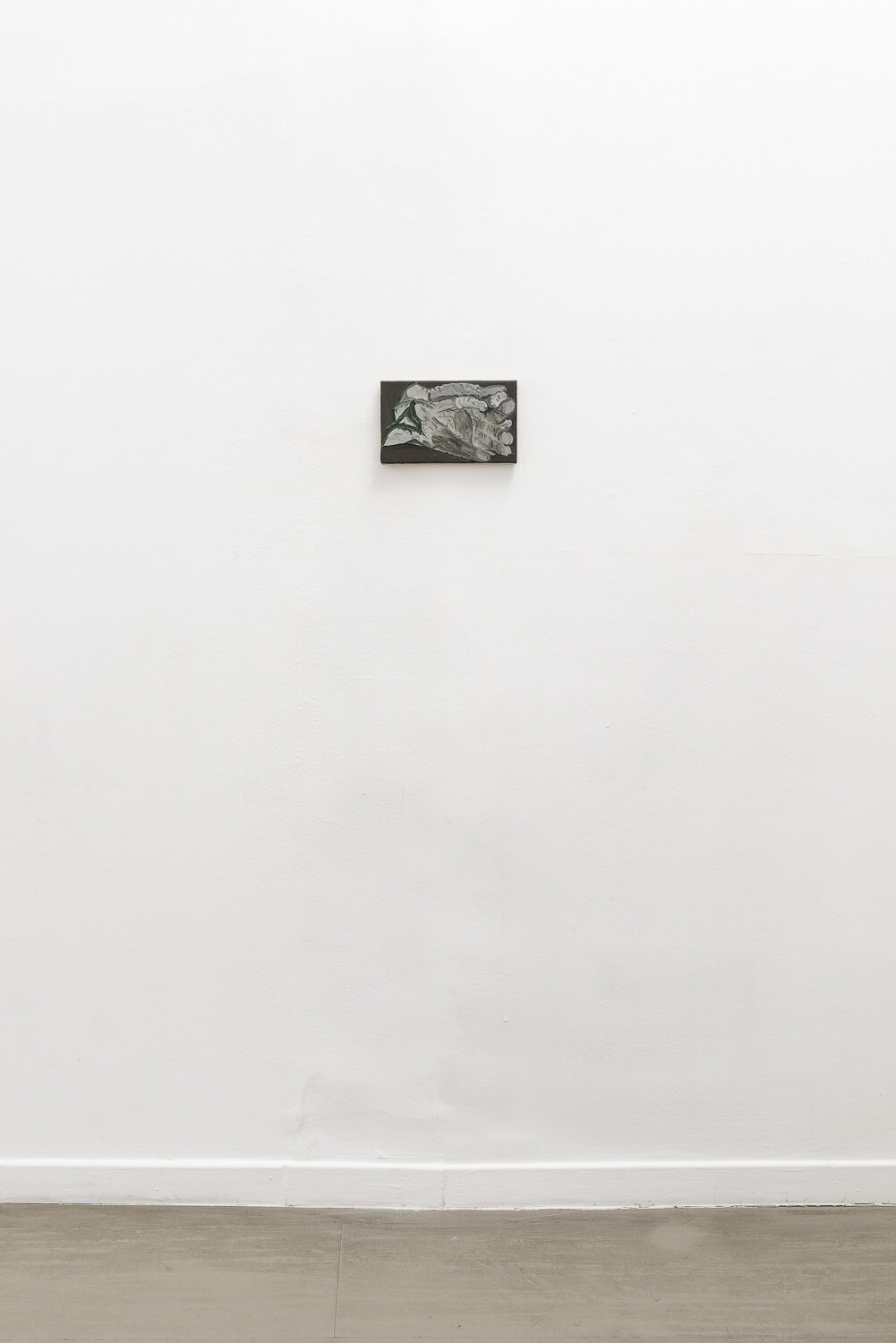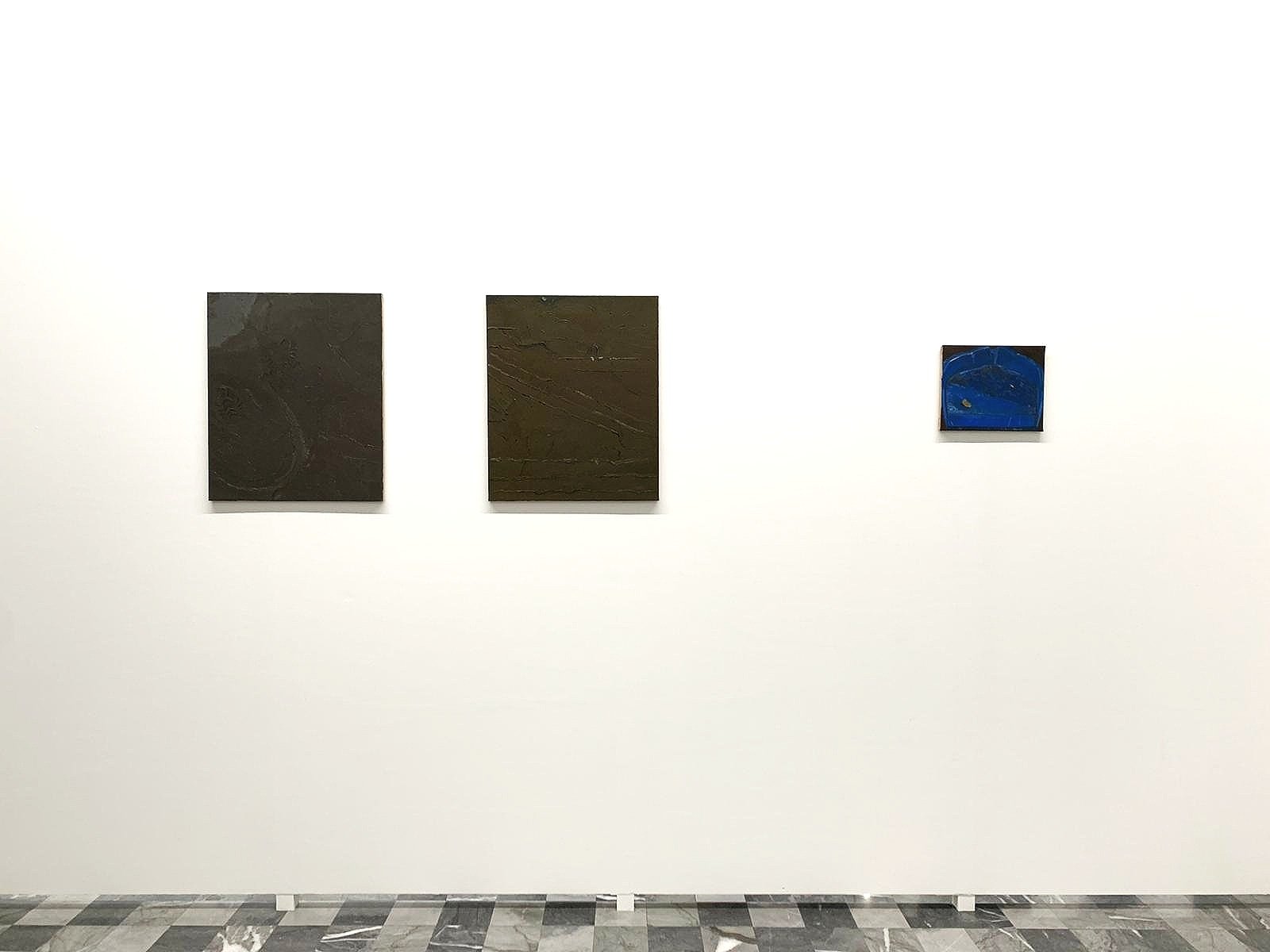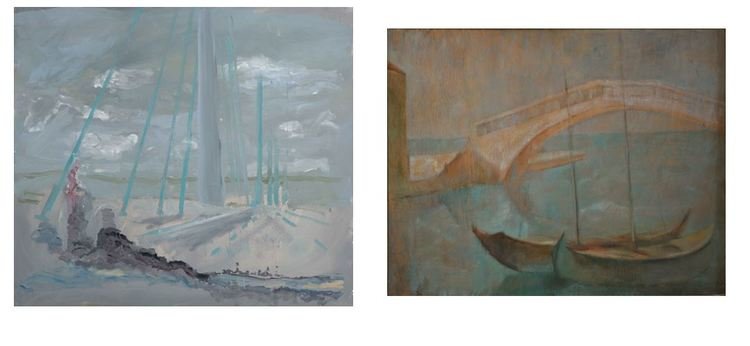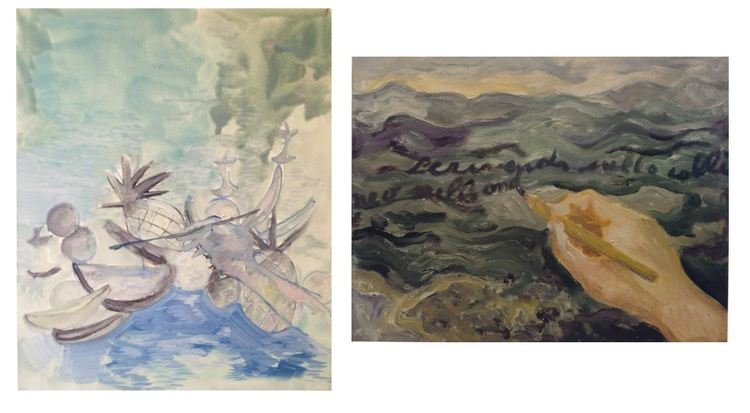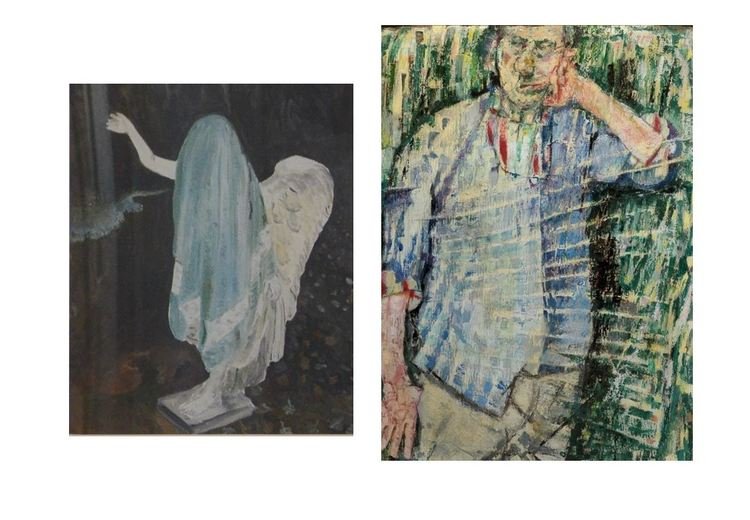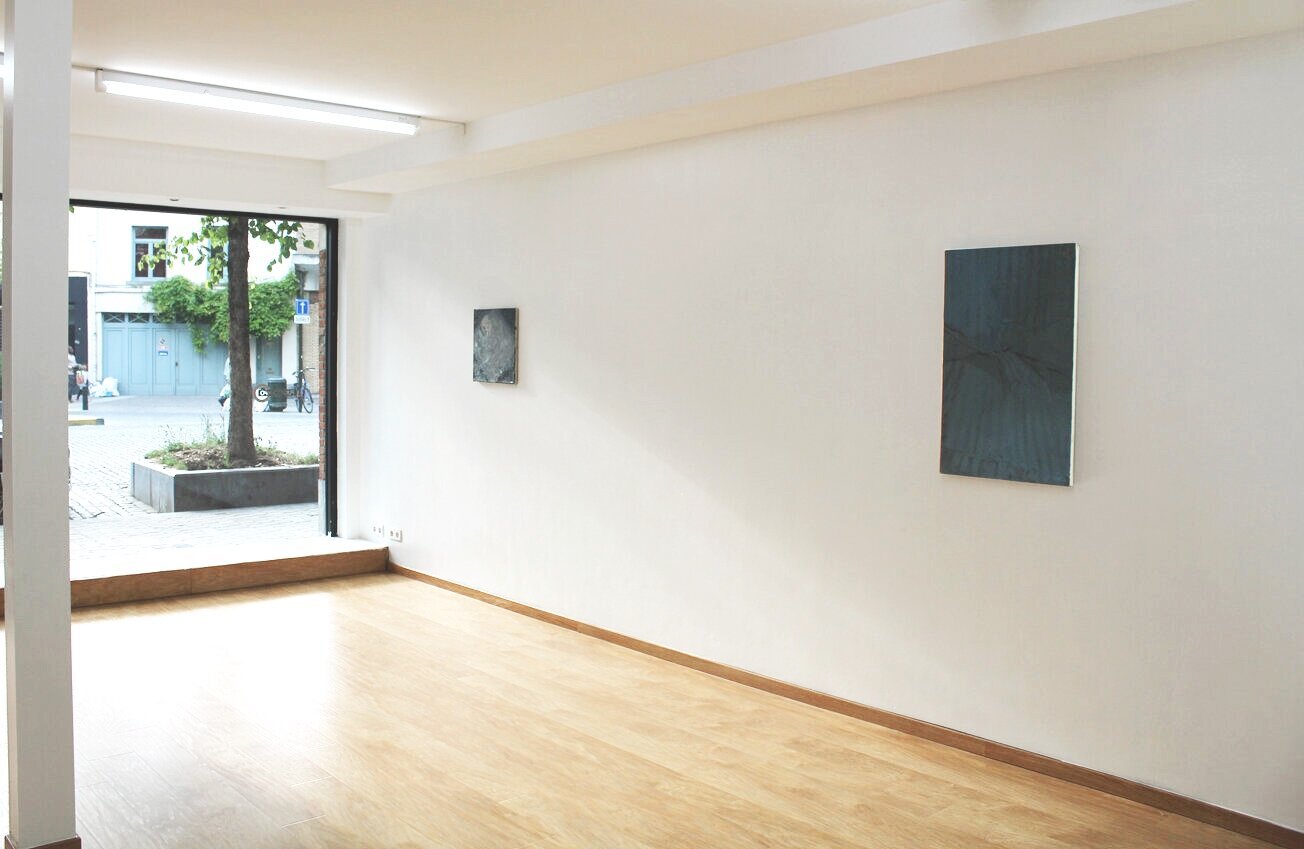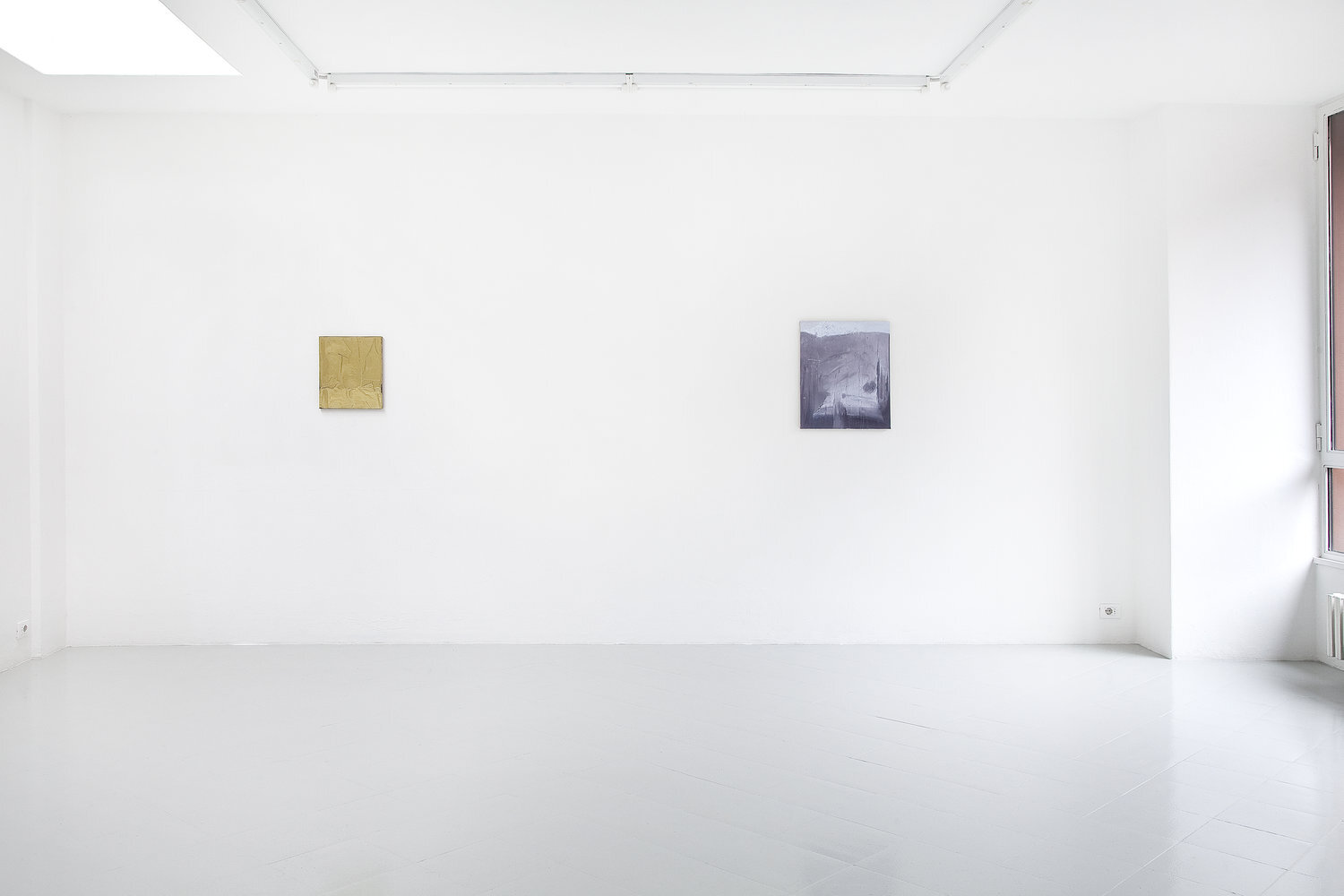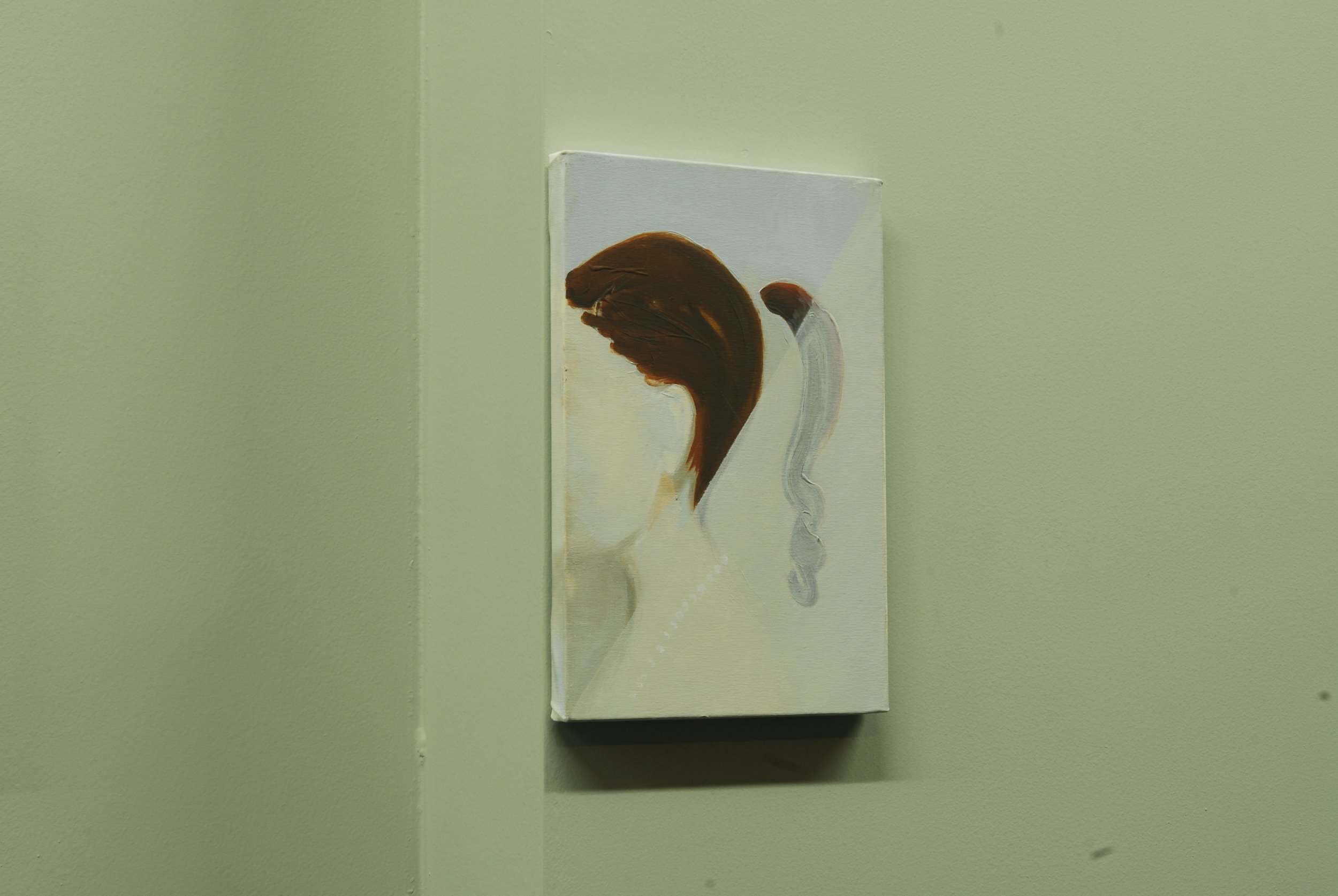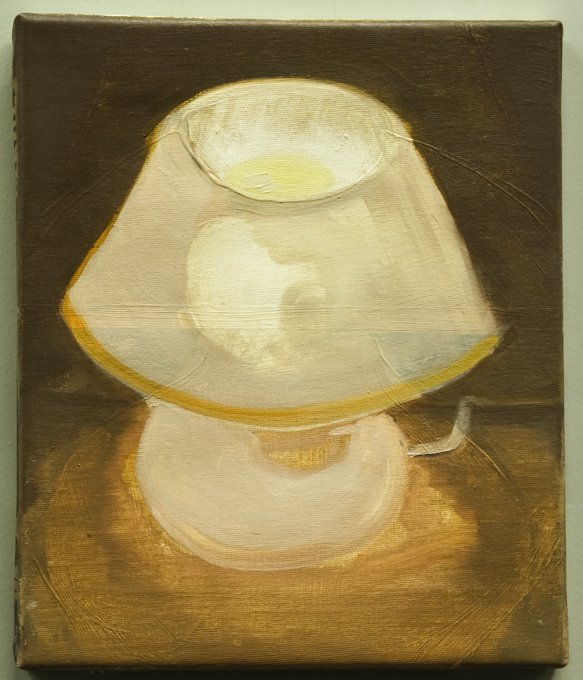Scroll down…
Sea Wall
with David Schutter, Curated by Andrew Mummery, A-M-G5, Glasgow UK
What is a painting? What is its relation to perception?, to power?, to tradition?
What does it mean to spend time looking at, or making a painting; to attend to it?
Writing about the artist Thomas Jones in the TLS in 2003, Merlin James asked, “What does it mean to give an accurate, matter-of-fact description of the world, or part of the world, or something in the world? When we try to describe objectively what we perceive in front of us, or around us, to what extent are we giving an account of ourselves - of our own impressions? How do we set limits on what we choose to describe, decide what’s the focus our attention and what is incidental or “background”? How could someone judge the reliability of our account, without recourse to that part of reality it purports to record (yet why make a “copy” of appearance at all, if not in anticipation of the absence of the original)?”1
David Schutter is a painter living and working in Berlin. His practice is based on the close study of carefully selected Old Master paintings, taking into account every aspect of the original work, including its composition, the pigments used in its manufacture, and its historical context. (Recent examples, including the one in this exhibition which is after a small painting of seaside dunes by Jacob van Ruisdael, consider ‘landscape’ as a historical form associated since the seventeenth century with the expansion of European capital and imperial power.) From memory Schutter ‘re- makes’ the source painting to its original scale using all the information he now has at hand. His paintings become performative re-enactments of their sources. Schutter considers his process to be one, not of recollection, but of repetition; a repetition of seeing and a repetition of painting. One of the questions his work asks is how do you situate the past in the space of the present?, especially when the past is a contested landscape. Schutter is clear that he does not want his paintings to be read as speaking of some kind of loss in the reactionary sense of an attempt to return. In many ways his work speaks of the fact that the past can’t be returned to. There is a melancholy here, but this not endgame painting. Instead something about “making” is revealed.
Michele Tocca is a painter living and working in Rome. His paintings in this exhibition are depictions of remaining sections of that city’s ancient Aurelian Wall made on site in one sitting in whatever conditions were pertaining at the time. They are in the tradition of the oil sketch which originated in Italy in the sixteenth century and had, by the end of the eighteenth, become an established part of an artist’s repertoire. The oil sketch encouraged the direct observation and recording of nature and the taking of notes of its particular details. Its virtues were seen to lie in its precise admixture of artifice and nature, its delicate interrogation of medium, its teasing equation of painterly and perceptual presence, of the artist’s and the viewer’s subjectivity and objectivity. In Tocca’s work observation, memory and imagination combine in a continuous interplay between the particular sensory and tactile immediacy required when working out of doors. Despite their attempts at objectivity, Tocca’s landscapes are never neutral but always carry in them the presence of the artist; his body, his breathing and his movements as an observer and actor in the space he is occupying. The duration of the sitting is important, “the experience held for the time of the making and then perceived after the experience is over. And that experience is not simply one of passive observation which is then transferred into two dimensions. It is the experience of actively apprehending the world by depicting it: not just describing it as one sees it, but seeing it as one describes it.”2
1 Merlin James, TLS, June 13, 2003, p.18.
2 Ibid.
https://www.a-m-g5.co.uk/exhibitions/
DRAWINGSSSSSSSS
Curated by Maria Chiara Valacchi/Antonio Di Mino, Studiolo Bureau, Milan 2024-25
a selection of more than 50 works on paper by Amélie Bigard, Agostino Bonalumi, Lupo Borgonovo, Anna Capolupo, Valeria Carrieri, Giacinto Cerone, Gianni Caravaggio, Pier Paolo Calzolari, Roberto De Pinto, Gianni Di Rosa, Diego Gualandris, Marco Gobbi, David Horvath, Fausto Melotti, Jimmy Milani, Elias Njima, Eliott Paquet, Pierre-Alain Poirier, Luigi Presicce, Pietro Roccasalva, Andrea Romano, Gino Severini, Mario Sironi, Michele Tocca, Francisca Valador, VenerdiSabato
Little Dawn, 2024
ph. Michela Pedranti
Hm, He, Ha
Pesce Khete/ Michele Tocca, Pt 1, Curated by Elena Volpato and Davide Ferri, Fondazione Coppola, Vicenza IT - June-September 2024
Fondazione Coppola is happy to announce the two-part exhibition HM, HE, HA – curated by Elena Volpato and Davide Ferri. Part one features a dialogue between Pesce Khete and Michele Tocca, and will be open starting June 1st 2024 through September 14th 2024. Part two will display the artworks of Luca Bertolo and Manuele Cerutti.
A first glance at an artwork might leave you with unexpected feelings, be those of reflection, surprise or puzzlement: the title of the exhibition HM, HE, HA references the exclamations that accompany this first exposure. It is also a direct nod to the homonymous lecture on “art and words” held by Julian Barnes, an author loved by both the artists and the curators. When explaining the reasons for the peculiar title he chose, he pointed at Edgar Degas’ words: “My art, what do you want to say about it? […] among people who understand, words are not necessary, you say humph, he ha, and everything has been said.”
Those exclamations are typical not only of the public, but also of the artists. The process of a painter, specifically, is deeply connected with their chosen medium: they work through estimates and approximations, pauses and comebacks, all reactions to the artwork slowly gaining shape and to how the materials used interact on the paper or canvas.
Through the two exhibitions, we wish to give value to a painting process that welcomes creativity and self-reflection, and that actively looks for doubts and obstacles to face, as to not fall into the pit of a “self-mannerism” in which the authentic style of the artist turns into a method to follow.
Thus, the four artists of the exhibition do not share a theme or style, but an inclination to see painting as a practice that is always inquiring about its own limits.
The first part of HM, HE, HA will display 35 recent artworks that weave together the artistic journeys of Pesce Khete and Michele Tocca and the Torrione itself. The images and atmospheres created by the artists will come in contact with the architecture of the watchtower, evoking feelings of alertness and anticipation in a timeless place caught between the past and present.
Pesce Khete’s works embrace remnants of the last century: images of soldiers waiting, as if in a positional warfare, emerge from the paper through almost satirical deformations. Next to them, we can see open views and landscapes, but also twisted brushstrokes and overlapping materials push the boundaries of our perception.
Where Khete creates earthy dreamlike barricades and trenches, Michele Tocca displays Fango [Mud] and Mura Aureliane [Aurelian Walls], the latter filling the canvas with vertical brick structures, creating a mise en abyme effect with the walls of the Torrione itself. On the other hand, the studies of clouds, and the open skies, featured in some of Tocca’s works, reflect an elective affinity with the horizon depicted by Khete in Untitled (Michele), an artwork that also highlights the two artists’ friendship through its title. The dialogue between their practices calls for a back-and-forth between the two: the focus on everyday objects by Tocca ignites the figurative motifs in Pesce Khete’s artworks, while the visual impact of the latter’s large paintings contrast and accentuate the former’s smaller canvases.
This narrative created between the two artists, develops up to the last floor of the Torrione. Open onto a view of Vicenza, the feeling of waiting, of a time that comes after the intensity of the work, takes shape. It is Tocca’s series, In One Coat, composed of contemplative images of brown jacket, against a background of blue sky. Alongside it and interspersed with it, Siliconi (Silicones) by Khete, are also traces of a time gone, symbols of a lost communication, imitations of the gluey remains that we can find behind removed street signs or store signs. The Siliconi, and their cursive doodles, as if of writing without an alphabet or letters, take us back to the small exclamations HM, HE, HA and to the momentary interruption of speech that gives in to the game of hesitation between thoughts and images.
ph. Dario Lasagni
Poca notte
[a bit of night]
Curated by Davide Ferri, z2o Sara Zanin Gallery, Rome 2024
Installation View. Ph. Dario Lasagni
Poca notte [a bit of night], Michele Tocca’s first solo show at Galleria Sara Zanin, seems to reference a specific moment in the day that corresponds to a particular condition of seeing, an intermediate time between night and day, when the earliest glimmers and lights open up vision, first faintly, then resonating in the darkness.
Poca notte is, first and foremost, a path of the light. It starts, ideally, with the largest of the works on display, The window (a bit of night) in which nine overlapping paintings configure a black surface with the minimal indication of depth given by the picture frame/window frame painted around each one, a "quasi-monochrome," in which each work’s layer of black paint has a flowing, animated quality. Add ambiguous to that. What causes, for example, those irregular veils or rifts of white that seem to expand and contract in each frame? Is it water vapor, dirt on the glass, reflections, light and shadow of landscape only vaguely perceptible from inside? Or is it all these things together? Likewise, what are those thin, irregular lines that furrow the top of one of the window’s panes? Cracks in the glass? Cobwebs? Glare from outside?
Getting back to the path of light. It started with The window (a bit of night) and continues with 9 am, it melts, a landscape filtered through condensate formed on the glass. The cloudiness on the window blends with the mistiness outside (clouds, mist) and establishes a continuous vision between inside and outside that leads to By dawn (Violet), a small painting isolated on a wall in which the purple light that appears before dawn is a presage of light’s later unstoppable expansion. By dawn (Violet) also suggests growth (an increment, precisely) that’s clearly capable of expanding on the wall and into the space around it, a luminous movement born of blackness, not only of the night, but also of the brushstrokes that summarily describe the frame of the pair of glasses that frames the image.
There’s what I would call an unprecedented aspect of Tocca’s work: a common thread running through the show, black, (in contrast with the path traced by light), because if I had to think of a color that has always appeared in his painting, it would be brown, a singular brown, however, one that succeeds in providing his paintings with a sort of “muddiness” and vibrant brightness at the same time.
In Poca notte, every vision of light seems instead to start from blackness or be framed by it, such as in By dawn (Violet) but also in the smaller paintings titled Ray opposite and Before they wake up, visions seen through binoculars of houses dotting the landscape nearby, still fast asleep, and in Light lighting, giving a view of sky between a mountain ridge and the edge of an umbrella (black) glimpsed while walking on a rainy morning.
This show also features red, a red I’d never really seen before in any of his paintings (Too late) but which appears in that sweater hung on a frame in the last painting the visitor sees before leaving the show on the wall across from the entrance.
La finestra (poca notte) / The window (a bit of night), 2024. Oil on canvas, 150x150 cm. Ph Dario Lasagni
Installation View. Ph Roberto Apa
Installation View. Ph Roberto Apa
Dawn (Violet), 2024. Installation View. Ph Dario Lasagni
Installation View. Ph Dario Lasagni
Raggio di rispetto/ Ray opposite, 2024. Oil on canvas, 17x19 cm. Ph Sebastiano Luciano
Installation View. Ph Dario Lasagni
Yesterday’s news, 2024. Oil on canvas, 35x40 cm. Ph Sebastiano Luciano
Installation View. Ph Dario Lasagni
for images and full text, visit:
https: //www.z2ogalleria.it/exhibitions/96-michele-tocca-poca-notte-curated-by-davide-ferri/overview/
Michele Tocca. Repoussoir
Curated by Elena Volpato, GAM - Galleria Civica di Arte Moderna e Contemporanea, Turin 2023
The exhibition stems from the desire of the GAM, Turin, to acquire a group of works by Michele Tocca, a painter capable of observing the world with the immediacy of an inner ‘first-timeness’: with the candour of a gaze that knows how to see everything as if it were the first time, yet cultivates a profound knowledge of the mechanisms of vision, the structures of thought and the legacies that art has handed down to us.
A few small, carefully selected pictorial studies have been taken from the GAM’s nineteenth-century collection and arranged high up on the walls, as if they were ideal notes, while Michele Tocca’s pictorial series are located at the line of vision. A chromatic distinction also separates the painting of the present from that of the nineteenth century on the wall, just as in the artist’s mind, at times, a more or less intense nuance of colour, the slightly closer perspective on the object or the more or less pushed synthesis of a brushstroke, separates his own doing from the living memory of what the plenairists were discovering between the eighteenth and nineteenth centuries, giving rise to a real revolution in looking and the emergence of a historical awareness of landscape.
Repoussoir is the title of a work in the exhibition by Michele Tocca, and also part of the acquisition that GAM has made thanks to the PAC2021 tender. The term repoussoir belongs to the history of landscape painting. It indicates an element placed in the foreground with the aim of constituting an obstacle, a frame, a wing to an unhindered vision. It is an obstacle that thrusts the gaze deeper into the work, determining its trajectory towards the visual focus of the painting. Tocca’s entire painting oeuvre can be read through the visual mechanism of the repoussoir: everything that is apparently marginal, that is apparently just a frame, a disturbance, a distraction, a filter, everything that is evanescent, everything that stands out from what we expect by habit to find at the centre of attention, acquires prominence and new meaning in his works.
This exhibition stems once again from the desire to affirm the full continuity between the history of art and its present-day evolutions, in a web of meanings, thoughts and techniques that only museums such as the GAM of Turin have the possibility of recounting, continuing to graft the tale of the present onto the solid trunk of its own collections.
June 22-November 5 2023
Opening June 21 with a lecture by Professor Anna Ottani Cavina
https://www.gamtorino.it/it/evento/michele-tocca-repoussoir/
Positions Pt 2
Curated by John Slyce, ALMA PEARL Gallery, London 2023
Larry Amponsah, Armando Andrade Tudela, Edmond Brooks-Beckman, Alice Browne, Richard Burton, Varda Caivano, Cecilia Charlton, Richie Culver, Milena Dragicevic, Simon English, Lydia Gifford, Margarita Gluzberg, Albano Hernández, Ansel Krut, Haeji Min, Evi Pangestu, Victor Payares, Catherine Repko, Ivan Seal, John Strutton, Michele Tocca, Amikam Toren and Nai-Jen Yang.
Scope, 2022
Installation View. Photo: Ben Westboy
https://almapearl.com/exhibitions/7-positions-part-two/overview/
L’avvicinamento
Curated by Gian Antonio Gilli and Manuele Cerutti, Mun ange Arte contemporanea, Crissolo (CN), Italy 2022
Installation View. Photo Munange
Lumacona, 2022. Oil on canvas, 60x50 cm. Installation View
Cloud Studies, 2022. Installation View
Mun ange’s second project for 2022 deals with the subject of the relationship between works of art and place. In this case, it is about an external place, a little outside of the village of Crissolo, towards east, on the right side of the valley. A mule track leads to a bridge that, over centuries, has been rebuilt after the floods of the fury of the torrent below during the season of the thaw. It is the area known as the Sbarme - an enclosed place, narrow, deeply marked by the voice of the torrent. A place that, during most of the bad season, is barely touched by the sun.
https://munange.it/2022-Michele-Tocca
Chiara Camoni.
Gorge, Bloom, Foliage.
World Above, World Below.
And Small Creatures.
Curated by Cecilia Canziani, Ilaria Gianni, Giulia Gaibisso, IUNO, Rome 2022
Exhibition View, IUNO, Rome. All photos by Sebastiano Luciano
Chiara Camoni's exhibition Gorge, Bloom, Foliage. World above, world below. And small creatures is a porous project that has involved walks, discussions, get-togethers and now hosts a selection of works by Michele Tocca.
Camoni's installation Piatti - simultaneously vegetal form sculptures and usable objects - and the series Sul perché in natura tutto avvolge a sinistra dialogue with three pictorial works by Michele Tocca from the series Cieli e Fanghi (Skies and Muds), portions of landscape made en plein air.
Chiara Camoni's exhibition, which opened on April 12th with a walk through the city led by Michele Tocca, will thus close with a further dialogue between the two artists.
Trattare l’aria.
Ipercorpo XVIII
Curated by Davide Ferri, Exatr, Forlì, IT, June 2022
Installation View, Photo Gianluca Camporesi
L’espressione “trattare l’aria” sembra sottesa da un desiderio che ha a che fare con il presente: è in fondo quello che vorremmo fare tutti da qualche tempo a questa parte. Trattare l’aria nel senso di trovare un modo per vedere l’aria: colorandola, perché no, di toni che ne segnalino le zone di pericolo, quelle tossiche, le correnti da cui stare alla larga…
Se ci penso trattare l’aria, cioè utilizzare ciò che è invisibile, pulviscolare, incorporeo alla stregua di un materiale (Invisibile, incorporeo: era questo il titolo di una mostra di Pier Luigi Tazzi di alcuni anni fa) è un desiderio più antico e profondo, e anche un’ambizione irriducibile degli artisti, che può tradursi in un racconto che va da Duchamp a Cai Guo Qiang, per prendere solo un segmento di una storia che potrebbe retrocedere di molto, o avanzare fino a questi anni.
Gli artisti inclusi nella sezione di questa edizione hanno provato, in modi diversi, a trattare l’aria. C’è chi ne ha fatto una forza in grado di agire sul corpo dell’opera, chi l’ha resa una forza visibile, chi ha provato a descriverne i movimenti, chi l’ha rappresentata con gli strumenti del disegno e della pittura. I lavori presentati, uno alla volta per sei giornate distribuite nelle due settimane di Ipercorpo, compongono insieme, più che una mostra, una partitura che, come una corrente d’aria, attraversa i diversi spazi del festival.
Davide Ferri
HIC
curated by Saverio Verini and me, z2o Project, Roma 2021
with works by: Olivo Barbieri / Giovanni de Cataldo / Alessandra Giovannoni / Pesce Khete / Jacques Julien / Stella Laurenzi / Jacopo Martinotti / Calixto Ramírez Correa / Alessandro Sarra / Michele Tocca
Exhibition View, Z2o Project, Rome. All images by Sebastiano Luciano
Rome is “a city where everything has already happened”, as recently put by Nicola Lagioia in his book La città dei vivi. And yet Rome never ceases to suggest clues and visual metaphors, to manifest its bulky and indecipherable grace that emerges walking along the Lungotevere on bright days, but also when it rains, stuck in traffic, from construction sites and uprooted Sanpietrini.
Fragmented, tragical and poetic: Rome’s is a vertiginous and conflictual complexity that does not obey to the cliché of the “Eternal City”, let alone the rhetoric of decadence. This is perhaps why, lately, Rome seems to be stirring a growing curiosity, attracting and influencing artists’ imagery.
HIC, group exhibition curated by Saverio Verini and Michele Tocca, puts together a stratified and visceral portrait of the city. A journey made of works in which one can feel Rome and its landscape, its dormant yet untamed nature, self-deprecation, disillusionment and echoes of its glorious past that does not impede traces of monumentality – if fragile – to be found in the present. Darker and viscous visions alternate with others typified by a precarious light, nevertheless able to illuminate shadows.
The selection includes artists born and raised in Rome along with others who have chosen it as their city of adoption, passers-by authors and residents at foreign academies. A combination of artists who know Rome as the back of their hands and others who have caught its character despite their temporary permanence. The nine invited artists are: Olivo Barbieri (Carpi, Italy, 1954), Giovanni de Cataldo (Rome, Italy, 1990), Alessandra Giovannoni (Rome, Italy, 1954), Pesce Khete (Rome, Italy, 1980), Jacques Julien (Lons-le-Saunier, France, 1967), Stella Laurenzi (Rome, Italy, 1989), Jacopo Martinotti (Milan, Italy, 1995), Calixto Ramírez Correa (Reynosa, Mexico, 1980), Alessandro Sarra (Rome, Italy, 1966).
With works spanning from installation and photography to video and painting, the display returns oblique views on Rome and its suggestions, presenting a fragmentary and antirhetorical portrait of the city. HIC is accompanied by a self-produced publication that includes extracts from books, tales, poems, essays and films as well as images, collected by the curators over the preceding months: a sort of anthology in which texts and works find unexpected correspondences, mirroring and relaunching each other reciprocally.
Verticale terra
Fabrizio Prevedello/ Michele Tocca, curated by Davide Ferri, Z2O Sara Zanin Gallery, Rome 2021
Exhibition View, Z2O Sara Zanin Gallery. All images by Sebastiano Luciano
Verticale terra features works by Fabrizio Prevedello and Michele Tocca. Not a double solo show, this dialogue between different poetics runs along a single story narrated through the gallery’s three rooms that provides common ground for the two artists’ forms of expression: Prevedello’s sculpture and Tocca’s painting and is based on the perspectives and movements of the gaze fostered by their works, on one hand, and certain vaguely recurring themes, on the other.
Prevedello develops his ideas through his materials of preference—plaster, and different varieties of marble but also slate, onyx—found and carted off during his wanders in the Apuan Alps, his chosen place of residence and perennial source of inspiration. Many of his sculptures arise from fragments of places he has traversed, which when combined, assembled or enclosed in structures made with common building materials like reinforced concrete and iron (through workman’s gestures wrought in myriad ways) give life to three-dimensional composite shapes. While leaving options open for the possibility of an inside, an underside or a backside, very often his works do not emerge far from the wall, in this way offering a privileged vantage point to the viewer, together with surfaces and fields capable of expanding a landscape’s character in space or the messages coming from different panoramas as devices capable of reconfiguring and reinventing one’s view of a location.
Tocca’s works seem instead derived from a minimal view of the ordinary, things happened upon during a stroll or inside a domestic environment, set aside in marginal spaces, of which every painting is a portrait, a translation of the thing’s ‘here and now” based on the process of taking measure of the visual appearance and the atmosphere of the live, the living. Tocca’s canvases can thus coincide with landscape and landscape painting while alluding to history’s unescapable suggestions (vedute, in particular, as well as a certain school of travel painting) or paintings with the image of an object that once painted on an undefined plane preserves the marks of time and surroundings in the folds and imperfections of its surface. The subjects of Tocca’s paintings draw the observer into a first-hand, close-up view, directing it downward or upward (or toward a horizon line grazing the painting’s upper edge) and are repeated in series with minimal variations of light and nuance that give the painting their overall tone and tenor.
Verticale terra is an exhibition of surfaces: hard and sharp here, dusty and hazy there, a dialogue between fields—the range of whites, grays, and blacks of Prevedello’s marbles and the earthy yellows, grays, and browns on Tocca’s palette—that may take on the appearance of a match-up or a musical score in which different tones are triggered and instigate one another in turn.
Tocca and Prevedello’s works also share certain aspects of formal nature: the tendency of both to construct images that develop around a tightly plotted foreground seen from up close with slight traces of depth in constant balance and contrast with the tactility of the surface.
Verticale terra also alludes to a movement in the way the works have been laid out: from the idea of a landscape revealed in vertical, ascent, and upward progression, and a descent to the horizontal (particularly in the works in the final room) and the ground at your feet, the destination of the dialogue between Michele Tocca and Fabrizio Prevedello.
D. Ferri
Pelle fiore, 2021
Fabrizio Prevedello, Accumulazione per scomparsa (Offenbach) 287, 2020
In the mud (parking lot), 2021
Drying shirt, 2020
Le realtà ordinarie
Curated by Davide Ferri, Palazzo de’ Toschi, Bologna 2020
Helene Appel (1976), Riccardo Baruzzi (1976), Luca Bertolo (1968), Maureen Gallace (1960), Andrew Grassie (1966), Clive Hodgson (1953), Maria Morganti (1965), Carol Rhodes (1959 - 2018), Salvo (1947 - 2015), Michele Tocca (1983), Patricia Treib (1979), Phoebe Unwin (1979), Rezi van Lankveld (1973)
Exhibition View, Palazzo de Toschi, Bologna 2021. All photos by Francesca Bertazzoni
Le realtà ordinarie investigates various aspects of painting in our time, unfolding around an idea of representation of “the ordinary”, and posing a series of simple questions: is there still an urge to explore traditional genres? How do painters follow or struggle against this impulse? What lies at the root of this seemingly endless fascination with ordinary subjects such as still lifes, flowers, landscapes, domestic interiors…? And why do we tend to consider their depiction an arena where no holds are barred, a space for pure visual pleasure, unfettered by the game of cultural allusions and citations?
The territory that this project attempts to map is therefore a permeable one, and potentially quite vast: it includes genre paintings (or ambiguous, fragmentary attempts to work within genres) as well as more hybrid or even abstract pictures inspired by little epiphanies, by the observation of minor everyday events or phenomena.
Le realtà ordinarie is also an exhibition about time, and how it flows in a seemingly unrippled stream around subjects and forms connected to the real world—whether they are varied and repeated, unfold in a series, or stand out as atypical within the featured artists’ oeuvre.
The show also examines a tradition grounded in the twentieth-century “return to order,” a trend that can be seen throughout Italian painting after World War I and the most feverish years of the avant-garde. It tries to reflect on the ambiguous meaning of the word “ordinary” (etymologically: obeying the usual order), bearing in mind how the current state of painting relates to the upheavals of its historical juncture.
Lastly, there is a light that seems to move through Le realtà ordinarie: a direct, noonday light that evenly illuminates things or transfigures them with its glare, pushing them towards abstraction—an abstraction of “light-colors” that suggests the memory of a figure, or alludes to the ordinary world through hints, echoes and vague presences.
D. Ferri
Paletta, 2016. Photo: Sebastiano Luciano
PITTURA XXI
Michele Tocca / Eugenia Vanni, FuoriCampo Gallery Booth, Arte Fiera, Bologna 2020
Exhibition View, 2020. All photos by Sebastiano Luciano
PITTURA XXI, section curated by Davide Ferri, Arte Fiera, Bologna. All images by Sebastiano Luciano
The dialogue between the works of Eugenia Vanni and Michele Tocca compares two different ways of seeing painting. Yet, regardless of their expressive distance, the paintings seem to move - both specularly and by contrast - towards a common conceptual horizon, that meets up in an idea of figuration considered between mimesis and visual participation.
An istinctual speed seems to characterise Tocca’s marks that move around the figural contours, the portrayed object, composing images that acquire details when observed from the distance in which the gesture gets lost in traits and form becomes figure. Differently, the calligraphic expertise employed by Eugenia Vanni to realise her canvases - the painterly imitation of the fabric - illuminates the nature of the painting behind the imitated object.
Tocca’s subjects seem suspended, they are transitory moments captured by the gaze. The framing in his pictures isolates the subject that becomes the teller of a story, whether it is a common thing or a perspective that goes beyond the evidence of traces and symbols, becoming more of a place for the ‘possible’ where the traces of events are exhibited
Vanni orientates her research within pictorial processes, materials, techniques, outcomes. She considers, that is, the grammar and the semantic rules on which the analysis between words and objects is based. Her portraits of informel, of canvases, of colours painting themselves are images of possible states of real things.
In both of their works, there seems to be a penchant for the representation of transitory moments: Tocca’s vapours and clouds catch a passing movement in the same way as Vanni portrays the action of priming, the gesture of a dripping. Times and processes are different though they show how it is possible to abstract from the register of a potential verity and to treat it as a subject to portray. How to overlap one’s own mood and representation, creating the illusion of abstraction through marks and shapes that recompose to fix the instant, the passages and the processes behind it.
J. Figura
Reality
Curated by Sue Kennington, Hickster Project, San Giovanni D’Asso, Siena, July 2019
Exhibition View. Image: Hickster Projects
Out Looking Inwards
LNM, The Norwegian Society of Painters + PRAKSIS, Oslo 2019
Study of Mount Kolsaas (d’apres Monet), 2019
PRAKSIS’s 13th residency, Painting Project: Out Looking Inwards brings together ten artists from Norway and around the world to explore questions surrounding contemporary painting and its possible futures.
The residents are: Robert Bordo (CA), Robert Holyhead (UK), Tina Kryhlmann (NO), Patrick McElnea (US), Matthew Musgrave (UK), Sarah Pettitt (UK), Hanneline Rogeberg (NO), Hanna Sjöstrand (SE), Michele Tocca (IT), and Piya Wanthiang (TH/BE).
Painting Project: Out Looking Inwards has been developed with artists Robert Bordo (CA) and Robert Holyhead (UK). The residency is held in collaboration with LNM (The Norwegian Painters Society).
Stupido come un pittore 2
Curated by Rossella Farinotti, Simona Squadrito, Villa Vertua Masolo, Nova Milanese 2018
Exhibition View. Photo: Alessio Anastassi
Artists: Linda Carrara, Giovanni Copelli, Mimmo Germanà, Giacomo Montanelli, Giulio Saverio Rossi, Michele Tocca
The first chapter of Stupido come un pittore explored, through a rarefied and atmospheric exhibition, the latest research by Thomas Berra, Sebastiano Impellizzeri, Pesce Khete, Nicola Melinelli and Valentino Vago; all artists who, although with different results, face painting through a close dialogue with light and space, a painting that becomes, in the most drastic declinations of this research – according to the curators of the exhibition – “extra-pictorial”.
If color, light, space and aniconicity were the central elements of the first chapter, landscapes, figures, scenes – together with the decorative element of painting – are the elements around which this second chapter develops. In addition to offering an overview of the research of “studio” painters, some artists directly address the spaces of Villa Vertua Masolo, proposing a series of site-specific interventions. Villa Vertua Masolo is therefore not perceived as a scenario for a display where painting is the sole protagonist, but as a subject around which revolve the artistic interventions.
P1 - Filling Station
Curated by Ingrid Toogood, SHE WILL, OSLO (NO) 2018
Exhibition View. Photo: Øystein Thorvaldsen
Artists: Ole Martin Lund Bø, Roger E.P Egseth, Liv Tandrevold Eriksen, Linda Hemmersbach, Camilla Holder, Nicholas John Jones, Jannicke Kristoffersen, Michele Tocca, Matthew Musgrave, Jorunn Hancke Øgstad
For its inaugural exhibition, She Will is thrilled to present ‘P1: Filling Station’. This exhibition places contemporary abstract painting within the remains of a recently closed petrol station. The strict functionality of the building itself and surrounding detritus remaining from the last 50 years of business are in stark contrast to the aesthetic and painterly concerns that are core elements of these works, and to the cleanliness of the white cube gallery space in which they are most often encountered. Featuring six artists established in the Norwegian art scene, and five international artists showing in Norway for the first time, ‘P1: Filling Station’ offers a unique opportunity to experience these works in this special environment.
‘P1: Filling Station’ is the first in an intended series of nomadic exhibitions initiated by Liv Tandrevold Eriksen and Ingrid Toogood that present painting in varied contexts outside of the gallery to explore if/how formal works change within unusual environments. At the core of this project is a belief that paintings come alive when they connect to inhabited spaces
Belvedere #1
Caffè Internazionale, Palermo 2018
Belvedere #4, 2018. Photo: Sebastiano Luciano
Belvedere, a series of paintings part presented at Caffè Internazionale, Palermo, rotates around a place, a painted place, the vista from a picture by Francesco Lojacono, 'Palermo e il Monte Pellegrino' (1875).
A sensorial, tactile handling characterises Michele Tocca’s paintings, dedicated to the direct representation of phenomena, circumstances and infinitesimal events. His is a territory in transformation, of comparisons among substances, times and events. A territory, in which the exploration of material and chronological interactions in the physical world, implies and overlaps with ruminations on paintings in its making – the questions, problems, approaches and clichés intrinsic to sur-le-motif painting. It is time – its effects and qualities (duration, cyclicality, coexistence …), the time of observation and execution – that dictates the rules of his production, made of series that develop over years.
In this respect, part of his work happens in places that have already been immortalised by painters from the past. Through researches that include the observation of paintings, old and new maps, google earth, notes and studies, such places are identified and visited becoming temporary studios. To return to routes traced by past painters does not involve, for Tocca, the idea of homage or a sense of nostalgia for a lost time. Rather, there is something picaresque and disabused in his search of places where time is stretched, suspended between the present and the past, imagination and reality. Places, that confound the aesthetic coordinates of our hyper-geolocalised present
Controcanto
Curated by Vera Portatadino, Yellow Space, Varese 2015
Het Hollandse Landschap (After the stolen Ruisdael), oil on linen, 57,5x49 cm. Photo: Yellow
Artists: Sigrid Holmwood, Sebastiano Impellizzeri, Enzo Marra, Michele Tocca
Extract from text
“Yellow shows the work of four artists whose research is based on their love of art history. Contemporary recantations, which revisit traditions, collective imagination, masterpieces, architecture and painting recipes of the Great Masters. A palinode (recantation), from the Greek πάλιν (pálin, “again”, "back") and ᾠδή (ode, "song"), is a poetical composition to retract a previous statement, often used to deny it. There are many examples in Greek and Latin literature. However, the meaning used in this case is a more literal one like a song searching and finding its muse from the past, which sings its beauty and greatness, showing it in a new vision, adorned with reminiscences and references. So amplifications rather than regrets. Alongside the ‘history of art’ known by most people, there is a controcanto (a counter song), a voice that sometimes blends in, other times differs, but always enriches the main melody. You can feel it appearing gently, very gently, together with the sun-kissed Dutch grass of Het Hollandse Landschap (or After Ruisdael), an interpretation of Ruisdael’s landscape by Michele Tocca. Here it rises and curls up in the foliage and engage in the clouds in the sky; then it is stronger and decisive in the hands of the peasants in the rural scenes after Millet and Van Gogh, painted by Sigrid Holmwood. These rural scenes smell of vegetable gardens and flowers, of earth and stones that the artist uses to make her own pigments by retrieving old recipes, awakening our lost sense of belonging to the world of nature and slowness…”
Pittura Italiana…
e altre storie minori
Casino dei Principi, Musei di Villa Torlonia, Rome 2015
Artists: Lorenza Boisi, Carlo Dalla Zorza (Venezia, 1903-1977), Carlo Levi (Torino, 1902-Roma, 1975), Ivan Malerba, Roberto Melli (Ferrara, 1885-Roma, 1958), Angelo Mosca, Fausto Pirandello (Roma, 1899-1975), Pio Semeghini (Mantova, 1878-Verona, 1964), Michele Tocca.
D’antan, 2012
Italian Painting … and other minor stories, curated by Angelo Mosca and Michele Tocca, in collaboration with Casa delle Letterature, Rome
In the exhibition, paintings by 20th-century artists Pio Semeghini, Roberto Melli, Fausto Pirandello, Carlo Levi and Carlo Dalla Zorza are re-involved in the present to be questioned by works by Lorenza Boisi,Ivan Malerba, Angelo Mosca and Michele Tocca.
Semeghini, Melli, Pirandello, Levi and Dalla Zorza are all figures who have deliberately occupied, to different extents, awkward, liminal positions within modernity, offering highly individual, probing views on major aesthetical discussions. They have contributed to shape the art of their time whilst paving the way for its future critical reconsideration, anticipating cultural concerns and trends, showing alternative and fresh possibilities for painting, influencing a number of seminal artists via their work and writings on art as well as via social and political initiatives. Their different degrees of recognition in the present, their oscillating fortuna critica, is surely a sign of the complexity of their legacy, of the transitional place they occupied and of the curious, unusual aspects of art they revealed: those other minor stories that expose how difficult and compelling it is to make sense of the kaleidoscopic panorama of inter-war painting with its fluctuations, traditions, experiments.
Removed from their role as epitome of a given historical climate, re-engaged in the present, their paintings resonate to the point that, in the exhibition, they slowly abandon their status as interviewees and start to question the works of Boisi, Malerba, Mosca and Tocca –none of which made in response to the show– about their role as paintings in the present.
With their stories, ruminations, formal qualities and metaphoric significances, the works on view exist autonomously as well as they imply, probe and test each other, taking on yet another new life together to articulate a polyphonic conversation piece, that unfolds painting as an ongoing inquiry into its necessity. The museum’s space becomes a sort of waiting room, where to whisper about the unstable boundaries between time and history; the new and the old; delays, afterthoughts and anticipations; the notion of minor and major works; the pastness and the presentness of motifs, genres and styles and the possibility of their survival and existence.
The discussion continues in the book published upon the occasion by Castelvecchi, in which writings by the artists and essays by art critic Alberto Mugnaini and Andrea Viliani, Director of MADRE, Museum of Contemporary Art, Naples, reflect on issues of fortuna critica; time, stories and history; empathy; untimeliness and anticipation; museum highlights and 'storage works'. The book is also an opportunity to read rarely published texts on art by the XX-century artists, including Carlo Levi's 1942 Paura della Pittura, an extremely lucid, vivid analysis of the notion of freedom in art and a heartfelt warning against the possible political uses of aesthetics; Roberto Melli's passionate, questioning and refreshing view of modernity in Casa d'arte (1918); and a selection of Fausto Pirandello's idiosyncratic, both humorous and metaphysical thoughts on painting.
Michele Tocca, 15-17/09/14, 2014 | Roberto Melli, Autoritratto, 1946. Fintermica-Jacorossi Collection, Rome.
Angelo Mosca, Sulle rovine, 2010/ Pio Semeghini, Ponte di Chioggia, 1938. Vicenza, Collezione Privata
Lorenza Boisi, Me as Matisse, 2013 / Carlo Levi, Scrivendo sulle colline, 1973. Fondazione Carlo Levi
Ivan Malerba, Park, 2007/ Fausto Pirandello, Autoritratto. Roma, Collezione Privata.
Studiolo. Italian Youth
Curated by Maria Chiara Valacchi, Museo Pinacoteca San Francesco, Republic of S. Marino 2014
Exhibition View. Photo: Davide Silvi
Artists: Pierluigi Antonucci (Popoli, Pescara, 1982); Marco Basta (Milano, 1985); Giulio Frigo, (Arzignano, Vicenza, 1984); Gaia Fugazza, (Milano, 1985);Michele Tocca, (Subiaco, Roma, 1983); Alessia Xausa, (Torino, 1991)
Altarino, 2013
Orange, 2014 / Cracks, 2014
Allegoria #2.
Painting beyond itself
Two-person exhibition with Angelo Sarleti, curated by Alberto Mugnaini, FuoriCampo Gallery, Siena 2014-’15
In Lorenzetti’s (the turret under storm), 2014
The show continues a project with Alberto Mugnaini, Angelo Sarleti and Michele Tocca, presented at the temporary space in Brussels, before the summer. In the space in Siena, Angelo Sarleti and Michele Tocca tackle this city’s complex identity, displaying a series of new works, created especially for the exhibition.
“In Siena, in its physical site and within its history, painting becomes ground-specific: It does not reflect or interpret the place, superimposing itself upon it; instead, it sets up a temporary camp on the place, becoming a place, a site unto itself. As if it had been displaced, it anchors itself to the ground, to the land and it witnesses its invisible relics. It takes on colour, and incorporates itself in the terra di Siena.
Painting today cannot fail to have, as its sole surviving frame, its tradition, the history inside which it is contained, and that, to an infinitesimal degree, it is required not only to continue, but also to rewrite, or perhaps reinvent: Painting exists here as a hermeneutics of place, and a channel for its memories to be unfolded in. It can only talk about itself, and reflect on the ways in which it pitches its field, and exists within a language of brush-strokes and colours, and on its position within its time and the way in which it draws itself out of that time, while at the same time exercising its prerogative to say other things, more things, and to engage in dialogues with the place, im-posing itself at the selfsame moment in which it ex-poses itself.
In Angelo Sarleti’s, we see the colours of Siena speak: the white and black of the city’s heraldic arms, and the gold background of its masterpieces. Their syntax takes form, and varies, as it engages with the language inherited from the abstract and geometrical tradition of modernity, in an epiphany that is at the same time heraldic and constructivist, that conceals that which it actually reveals: a coded discourse, an invisible elsewhere, a mathematical frenzy that recounts a number of aspects of the city’s economic history, within the chilling arithmetic of statistical sciences.
Michele Tocca’s painting is a process of questioning, and identification. The works originate on the scene, in the physical place that is investigated and explored. Painting opens itself up to the place at the time its enactment takes place, and sets itself up as an impression that becomes the representation of a trace, a relic of the gaze, and of the fleeting nature of the eternal, of its elusive, everyday aspect”.
Alberto Mugnaini
Polluted fresco, 2014
The Fate of Forms
Benjamin Senior and Michele Tocca, James Fuentes Gallery at the FLAG ART Foundation, New York 2014
Exhibition View, FLAG ART Foundation, 2014. Photo: Adam Reich
James Fuentes is pleased to present a series of new paintings by Benjamin Senior and Michele Tocca. A key element in both artists’ work is the direct observation of life. In Benjamin Senior’s work, this takes the form of a highly formalised and often fractured image, whereas Michele Tocca finds tactile painterly equivalents for things that can be seen but not always touched.
The title of this presentation is taken from the notes of André Derain for a treatise on painting, encountered by both artists at the Victoria and Albert Museum’s National Art Library at different stages of their researches. Rarely published during Derain’s life, his annotations foster reflections on nature, intuition, the transition between subjective experience and its objectification in form as accomplished via the conscientious observation of the appearances of the world.
Drawing on traditions of figurative painting, Senior and Tocca are concerned with the connection between painting and the world, an engagement with the visible which becomes a vehicle to reflect upon what it is to be painted; what to add to the ancient debate between observation and artifice; how to positively respond to conventions of representation and genre. Their works are brought together here as part of an ongoing conversation between the two artists and periods of painting together from the same scene.
Di un libro, guardo le figure (d’apres Derain), 2014. Photo: Filippo Armellin
Left to right: Benjamin Senior and Michele Tocca, Painting Faith (collaborative piece). Photo: Adam Reich
Left to right: Benjamin Senior and Michele Tocca, Ladle Hill (collaborative piece). Photo: Adam Reich
Exhibition View, 2014. Photo: Adam Reich
Allegoria
Curated by Alberto Mugnaini, FuoriCampo Gallery, Brussels 2014
Exhibition View, 2014
Angelo Sarleti and Michele Tocca show in two different spaces. Two solo shows that become an ideal dialogue.
Painting finds itself at the threshold with the invisible. Painting means the invisible: Tocca’s work inherits the touch and the stains of a certain XX-Century Italian figuration, whilst that of Sarleti echoes the spatial and geometric combinations of Modernism. This is the “look” of their painting. Yet both offer something unprecedented that brings them together: a sort of realism of the invisible, that goes beyond the phenomenon, the here and now, and takes on a “panoramic” dimension in a timely sense.
Painting finds in Tocca the responsibility to represent a protracted dimension of time as in a chronological stretching. The works seek for a permanence that the transitory and secretive aspect of visible phenomena in all of their open evidence, hide. Sarleti catches and verifies a substantial reality, the collection of data and their graphics, using the representation of statistics to infuse meaning and ‘blood’ in the trite geometric combinations of a century of abstraction.
Subject to (The pillow), 2014
Studiolo #10
Curated by Maria Chiara Valacchi, Studiolo Project, Spazio Cabinet, Milan 2014
Exhibition View, Studiolo 2014. All images by Filippo Armellin
Executed at different times, in different places and circumstances, each of Tocca's works tells about the encounter between things and painting. Within these paintings, tropes, traditions and genres are continuously researched and tested. A continuous inquiry exists between the processes of translation (nature and artifice, morphology and perception, determinacy and indeterminacy) and matter and light - diverse densities, reflections and fissures contribute to create forms as in a bas-relief. Yet intention and research always give way to intuitions and sensitivity in front of the motif. However personally significant, objects, places and phenomena never take on any symbolism, never mirror any personal feeling or impression. With their physical, tactile participation, the paintings address the very process through which objects become expressive and metaphoric for us, questioning our experience of things to encourage a critical meditation on the necessity of sur-le-motif painting.
Heavy Rain, 2014
In one coat; One coat [stretched, 2011
Show 11
Royal College of Art, London 2011
Exhibition View, RCA, London 2011. All images by Wendy McLean
Focus on board (The crisp), 2011
Exhibition View, with Matthew Musgrave, RCA, London 2011
Drawer, for the second time, 2011
Exhibition View, RCA, London 2011
11/05/2011 (Enid Seeney), 2011
Studiolo #4
Curated by Maria Chiara Valacchi and Marco Tagliafierro, Spazio Cabinet, Milan 2011
Loaf, 2010
Spazio Cabinet inaugurates a new exhibition at its project room Studiolo with a presentation of paintings by Michele Tocca, invited to expand his reflections on tactility and matter as an act of imagination and continue True Matter, the show in the main space.
Ramshackle canvases, irregular, self-made stretchers, uneven surfaces, fissures, cavities. These paintings are made from life in rustic environments with whatever was there, often victims of accidents occurred whilst working or during transportation. They are about the rural brought to cities, the grace found in error and accident, discomfort - about how necessary what goes wrong may be to reconsider success.
Fire works before rain, 2010
Casa di terra, 2010
Thinking of a rabbit, 2010
No more than a point of view,
Expanded Painting, Prague Biennale 4
Karlin Hall, Prague (CZ) 2009
Exhibition View
A4, 2009. Photo: Luca Carrà
Curated by Angelo Mosca, text by Alberto Mugnaini, Massimiliano Scuderi
Artists: Manfredi Beninati, Luca Bertolo, Lorenza Boisi, Gianluca Di Pasquale, Andrea Kvas, Ivan Malerba, Pesce Khete, Alessandro Roma, Michele Tocca
Ici
OTTO ZOO Gallery, Milan 2008
Otto Zoo Gallery is pleased to present ICI, a group show including four Italian painters: Robert Bosisio, Gianluca Di Pasquale, Angelo Mosca and Michele Tocca.The title ICI, the French for ‘here’, is inspired by the sign once written by Picasso on the entrance of his studio in rue des Grands-Augustins, Paris, stands for the importance of the ‘studio’, of the ‘practice within’, underlining a certain sense of adventure, of intimacy and sympathy; but it is also meant to be an invitation to read the show ici, here, principally accessing its meaning by the visual experience, rather than by recurring to more general themes.
Robert Bosisio (Trodena, 1963) represents intimate and symbolic landscapes suggesting the need to look beyond perception, by mean of juxtapositions of brushstrokes, colours and textures. Angelo Mosca (Chieti, 1961) intensely meditates on the stratification of memories, continuously and passionately experimenting on the possibilities of the canvas. Gianluca Di Pasquale (Roma, 1971) analytically, yet promptly, catches instants of life, in between rigour and immediacy. Made from observation in different times of the day, the small paintings by Michele Tocca (Subiaco, 1983), through the reconstruction of illusionary spaces, explore the tangible, subtle and playful nature of objects and figures, trying to grasp their certainty, their grave appearing and beauty.
Clara’s pony-tail. 2007
Meriggiare, 2007
Night beer, 2008
Abat-jour, 2008
